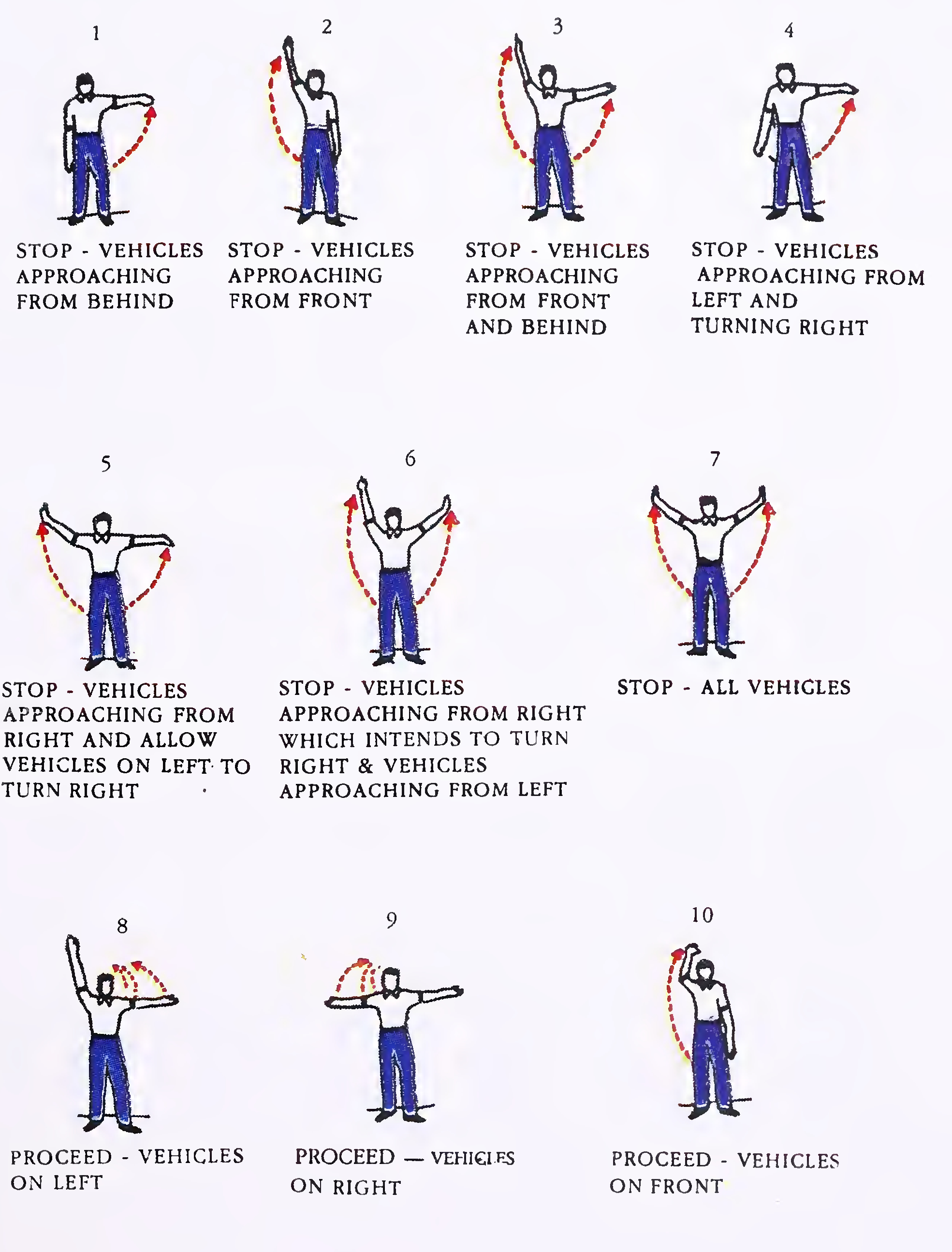
This library of books, audio, video, and other materials from and about India is curated and maintained by Public Resource. The purpose of this library is to assist the students and the lifelong learners of India in their pursuit of an education so that they may better their status and their opportunities and to secure for themselves and for others justice, social, economic and political.
This item has been posted for non-commercial purposes and facilitates fair dealing usage of academic and research materials for private use including research, for criticism and review of the work or of other works and reproduction by teachers and students in the course of instruction. Many of these materials are either unavailable or inaccessible in libraries in India, especially in some of the poorer states and this collection seeks to fill a major gap that exists in access to knowledge.
For other collections we curate and more information, please visit the Bharat Ek Khoj page. Jai Gyan!
Indian Roads Congress
Special Publication 44
Published by:
The Indian Roads Congress
Copies can be had from
The Secretary General, Indian Roads Congress,
Jamnagar House, Shahjahan Road,
New Delhi-110011
NEW DELHI 1996 Price Rs. 200/-
(Plus packing &
postage charges)
MEMBERS OF THE HIGHWAYS SPECIFICATIONS AND STANDARDS COMMITTEE
(As on 1.9.1992)
| 1. | R.P. Sikka (Convenor) |
... | Additional Director General (Roads), Ministry of Surface Transport (Roads Wing) |
| 2. | P.K. Dutta (Member-Secretary) | ... | Chief Engineer (Roads), Ministry of Surface Transport (Roads Wing) |
| 3. | G.R. Ambwani | ... | Engineer-in-Chief, Municipal Corporation of Delhi |
| 4. | S.R. Agrawal | ... | General Manager (R), Rail India Technical & Economic Services Ltd. |
| 5. | V.K.Arora | ... | Chief Engineer (Roads), Ministry of Surface Transport, (Roads Wing) |
| 6. | R.K. Banerjee | ... | Engineer-in-Chief & Ex-Officio Secretary to Govt. of West Bengal |
| 7. | Dr. S. Raghava Chari | ... | Professor, Transport Engg. Section, Deptt. of Civil Engg., Regional Engg. College, Warangal |
| 8. | Dr. M.P. Dhir | ... | Director (Engg. Co-ordination), Council of Scientific & Industrial Research, New Delhi. |
| 9. | J.K. Dugad | ... | Chief Engineer (Retd.), 98A, MIG Flats, AD Pocket, Pitampura, New Delhi |
| 10. | Lt. Gen. M.S. Gosain | ... | Shankar Sadan, 57/1, Hardwar Road, Dehradun |
| 11. | O.P. Goel | ... | Director General (Works), C.P.W.D. |
| 12. | D.K. Gupta | ... | Chief Engineer (HQ), PWD, U.P. |
| 13. | Dr. A.K. Gupta | ... | Professor & Coordinator, COTE, University of Roorkee |
| 14. | G. Sree Ramana Gopal | ... | Scientist-SD, Ministry of Environment & Forest |
| 15. | H.P. Jamdar | ... | Special Secretary to Govt. of Gujarat, Roads & Building Department |
| 16. | M.B. Jayawant | ... | Synthetic Asphalts, 103, Pooja Mahul Road, Chembur, Bombay |
| 17. | V.P. Kamdar | ... | Plot No. 23, Sector No. 19, Gandhinagar, (Gujarat) |
| 18. | Dr. L.R. Kadiyali | ... | Chief Consultant, S-487, IInd Floor, Greater Kailash-I, New Delhi |
| 19. | Ninan Koshi | ... | Addl. Director General (Bridges), Ministry of Surface Transport, (Roads Wing) |
| 20. | P.K. Lauria | ... | Secretary to Govt. of Rajasthan, Jaipur |
| 21. | N.V. Merani | ... | Secretary, Maharashtra PWD (Retd.), A-47/1344, Adarsh Nagar, Bombay |
| 22. | M.M. Swaroop Mathur | ... | Secretary, Rajasthan PWD (Retd.), J-22, Subhash Marg, C-Scheme, Jaipur |
| 23. | Dr. A.K. Mullick | ... | Director General, National Council for Cement & Building Materials, New Delhi |
| 24. | Y.R.Phull | ... | Deputy Director, CRRI, New Delhi |
| 25. | G. Raman | ... | Deputy Director General, Bureau of Indian Standards, New Delhi |
| 26. | Prof. N. Ranganathan | ... | Prof. & Head, Deptt. of Transport Planning, School of Planning & Architecture, New Delhi |
| 27. | P.J. Rao | ... | Deputy Director & Head, Geotechnical Engg. Division, CRRI, New Delhi |
| 28. | Prof. G.V. Rao | ... | Prof, of Civil Engg., Indian Institute of Technology, Delhi |
| 29. | R.K. Saxena | ... | Chief Engineer, Ministry of Surface Transport (Roads Wing) (Retd.) |
| 30. | A. Sankaran | ... | A-l, 7/2, 51, Shingrila, 22nd Cross Street, Besant Nagar, Madras |
| 31. | Dr. A.C. Sarna | ... | General Manager (T&T), Urban Transport Division., RITES, New Delhi |
| 32. | Prof. C.G. Swami-nathan | ... | Director, CRRI (Retd.), Badri, 50, Thiruvenkadam Street, R.A. Puram, Madras. |
| 33. | G. Sinha | ... | Addl. Chief Engineer (Plg.), PWD (Roads), Guwahati |
| 34. | A.R. Shah | ... | Chief Engineer (QC) & Joint Secretary, R&B Department, Gujarat |
| 35. | K.K. Sarin | ... | Director General (Road Development) & Addl. Secretary, Govt. of India (Retd.), S-108, Panchsheel Park, New Delhi |
| 36. | M.K. Saxena | ... | Director, National Institute for Training of Highway Engineers, New Delhi |
| 37. | A. Sen | ... | Chief Engineer (Civil), Indian Road Construction Corpn. Ltd., New Delhi |
| 38. | The Director | ... | Highway Research Station, Madras |
| 39. | The Director | ... | Central Road Research Institute, New Delhi |
| 40. | The President | ... | Indian Roads Congress [L.B. Chhetri, Secretary to the Govt. of Sikkim] -Ex.-officio |
| 41. | The Director General | ... | (Road Development) & Addl. Secretary to the Govt. of India -Ex.-officio |
| 42. | The Secretary | ... | Indian Roads Congress (Ninan Koshi) -Ex.-officio |
| Corresponding Members | |||
| 1. | S.K. Bhatnagar | ... | Deputy Director - Bitumen, Hindustan Petroleum Corpn. Ltd. |
| 2. | Brig C.T. Chari | ... | Chief Engineer, Bombay Zone, Bombay |
| 3. | A. Choudhuri | ... | Shalimar Tar Products, New Delhi |
| 4. | L.N. Narendra Singh | ... | IDL Chemicals Ltd., New Delhi |
HIGHWAY SAFETY CODE
This Code is not a manual of traffic law, although some of the measures dealt within it are prescribed by law. Others are dictated by good sense and courtesy. However, each category is as important as the other.
Based on the recommendations of the First Highway Safety Workshop held at Chandigarh in January, 1972 the Traffic Engineering Committee of the Indian Roads Congress decided to take up the preparation of Highway Safety Code. Since then this Code has been extensively discussed and modified several times by the Traffic Engg. Committee. The final draft of the Highway Safety Code was discussed in the meeting of this Committee held on 2.12.1991 (personnel given below):
| R.P. Sikka | .... | Convenor |
| M.K. Bhalla | .... | Member-Secretary |
| Members | ||
| A.K. Bandyopadhyay | Maxwell Pereira | |
| Dr. S. Raghava Chari | Prof. N. Ranganathan | |
| R.G. Gupta | T.S. Reddy | |
| Dr. A.K. Gupta | M. Sampangi | |
| H.P. Jamdar | D. Sanyal | |
| Dr. L.R. Kadiyali | Dr. A.C. Sarna | |
| J.B. Mathur | Prof. P.K. Sikdar | |
| N.P. Mathur | Dr. M.S. Srinivasan | |
| Dr. P.S. Pasricha | S. Vishwanath1 | |
| Ex-Officio Members | ||
| The President, IRC |
L. B. Chhetri (Road Development), MOST | |
| The Director General | ||
| The Secretary, IRC | Ninan Koshi | |
| Corresponding Members | ||
| Gopal Chandra Mitra | N.V. Merani | |
| V. Krishnamurthy | S.P. Palaniswamy | |
| K.V. Rami Reddy | ||
Thereafter it was approved by the Highways Specifications & Standards Committee in its meeting held on 1.9.1992, subject to some minor modifications to be carried out by a group consisting of S/Shri M.K. Bhalla & J.B. Mathur.
The modified draft was subsequently approved by the Executive Commitee on 11.11.1992 and by the Council in their meeting held on 28.11.92 subject to modifications based on comments of members of the Council.
The draft was finally modified by S/Sh. Nirmal Jit Singh & A.P.Bahadur in consultation with the Convenor, Highways Specifications & Standards Committee as authorised by the Council for printing as one of the IRC Publication. The finalised draft was received from Convenor, Highways Specifications & Standards Committee on 2.4.93 for printing as one of IRC publications.
The Highway Safety Code is designed to help road users to traverse the roads safely. It is intended to induce good traffic sense, discipline and courtesy in road users while familiarising them with the rules and laws governing the use of roads. It also gives tips on safe driving and explains meanings of road signs, pavement markings and signals met on the roads.
Driving on the highways is more demanding than ever before. It requires skill, concentration and caution to steer oneself safely on the road.
It is important that every road user knows and understands the2
rules of the road. Safe driving is a continuous learning process. Careful reading and compliance of the safety instructions contained in this code by all road users will go a long way imbibing safety culture, thus saving precious human lives, disabilities and injuries and mitigating socio-economic losses.
The Highway Code consists of a number of chapters covering various types of road users. Road users explicitly covered are Pedestrians, Animal Drawn Vehicles, Cyclists, Motor-Cyclists and other Motorised Vehicles. The gist of the whole document is given in the end in the form of Do’s and Don’ts for various road users. These summarise the behavioural and other attributes that the road user is expected or required to follow so that those who do not want to go through the whole document can derive the benefit by studying that part only. A brief driving and road craft manual has also been added. Some figures giving the various traffic signs and signals and some diagrams depicting various traffic situations are also included, so as to make the document more illustrative and easily understood.
Traffic Rules have been established as a systematic framework to serve as a guide and commitment common to all. Obeyance of traffic rules is a fundamental responsibility of all citizens. Everyone must follow the basic road rules and drive with common sense and with consideration for safety of all the road users.
It is everyone’s social responsibility to understand and follow the road rules, road signs and markings. Some of the general rules that should be remembered are:
Officer in uniform.
or pavement marking on traffic lanes, but do so with the greatest caution. (See Fig. 1 for typical hand signals by traffic police)

Fig. 1. Hand Signals by Traffic Police5
Everyone must obey all traffic signs, traffic lights and pavement markings. It is the duty of every person, not only vehicle drivers but also pedestrians and bicycle riders to become acquainted with traffic signs, lights and pavement markings.
There are specific standards for signs regarding their colour, shape and size. It is everyone's duty to know them and follow the message conveyed meticulously. Road signs transmit consistent and uniform messages about the travel route anywhere in the country.
In India, traffic signs are grouped under the following categories:
Traffic signals are generally installed at intersections to control the movement of vehicles. All traffic must move in conformity with the traffic lights or signals. Only heed the traffic light directly facing the direction in which you are moving. Even when the signal for the traffic on the side road has become red, it does not necessarily mean that your signal is green and that6

Fig. 2 (i) Mandatory/Regulatory Signs Sings Giving OrderS-Mostly Circular 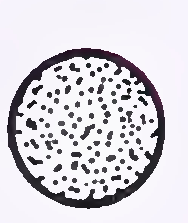 7
7
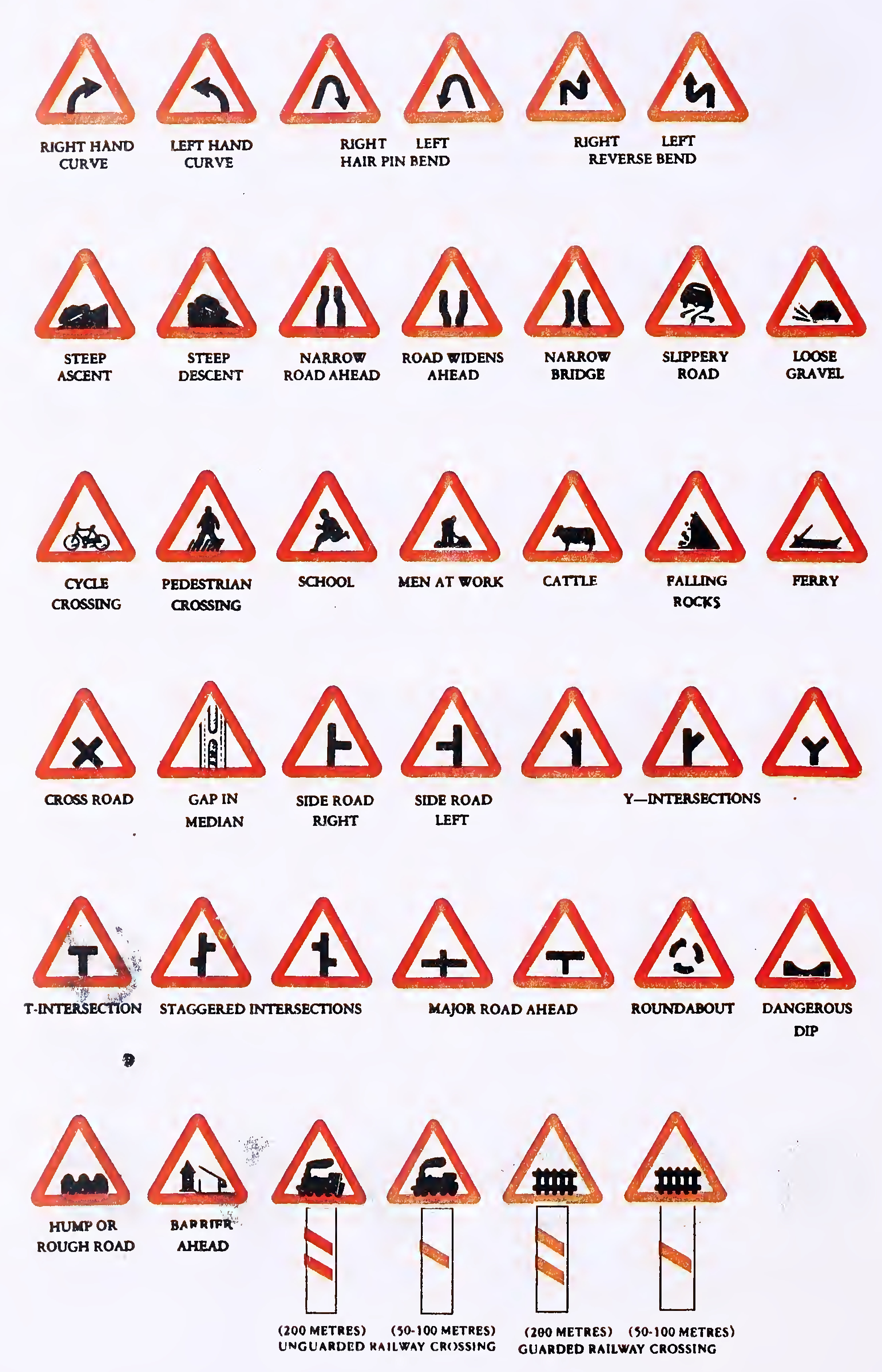
Fig. 2. (ii) Cautionary/Warning Signs-Mostly Triangular 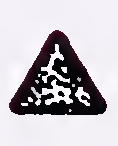 8
8
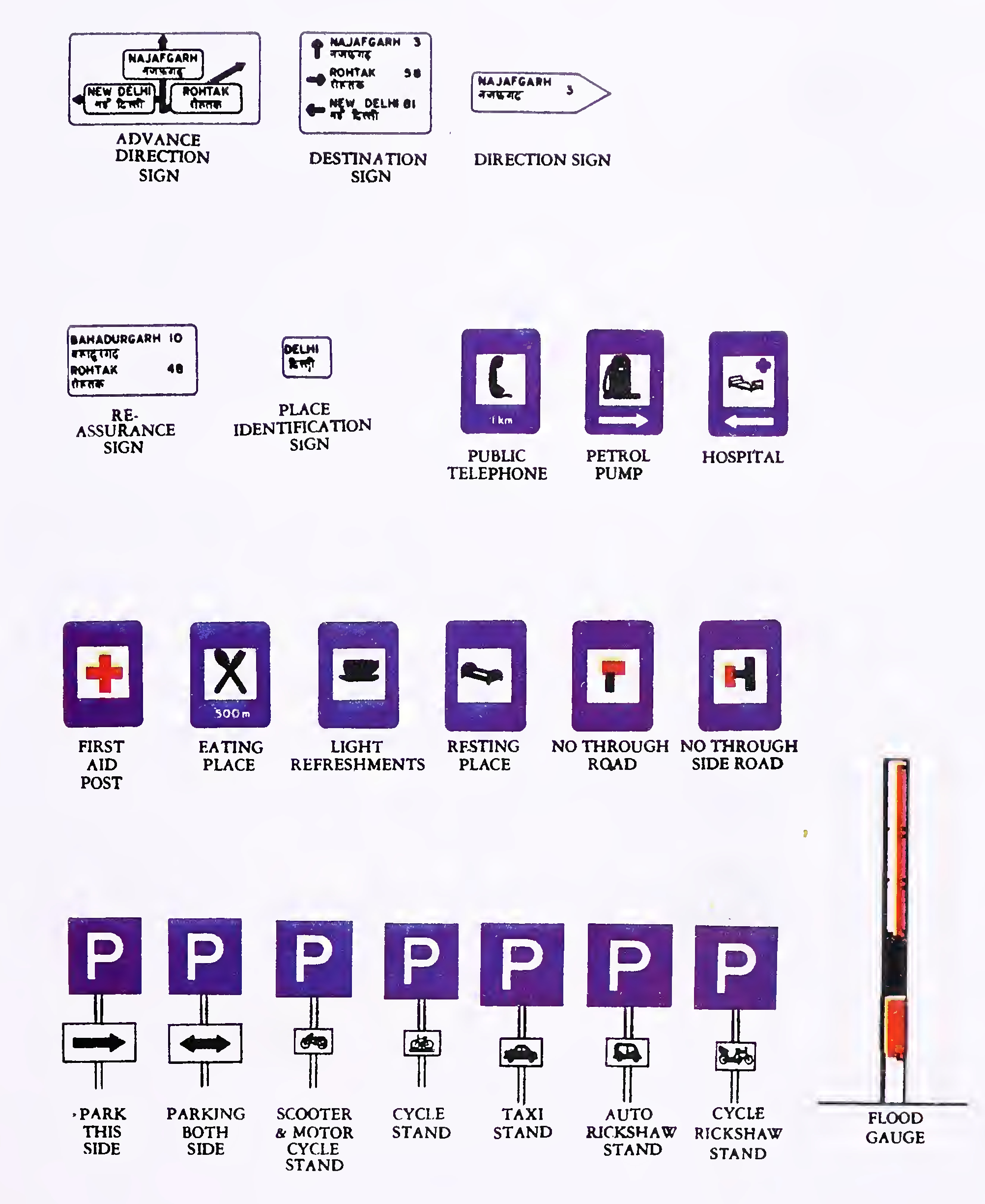
Fig. 2. (iii) Informatory Signs-Mostly Rectangular 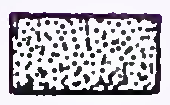 9
9
you are at liberty to go ahead. The signals indicate the following depending on the colour (see Fig. 3).
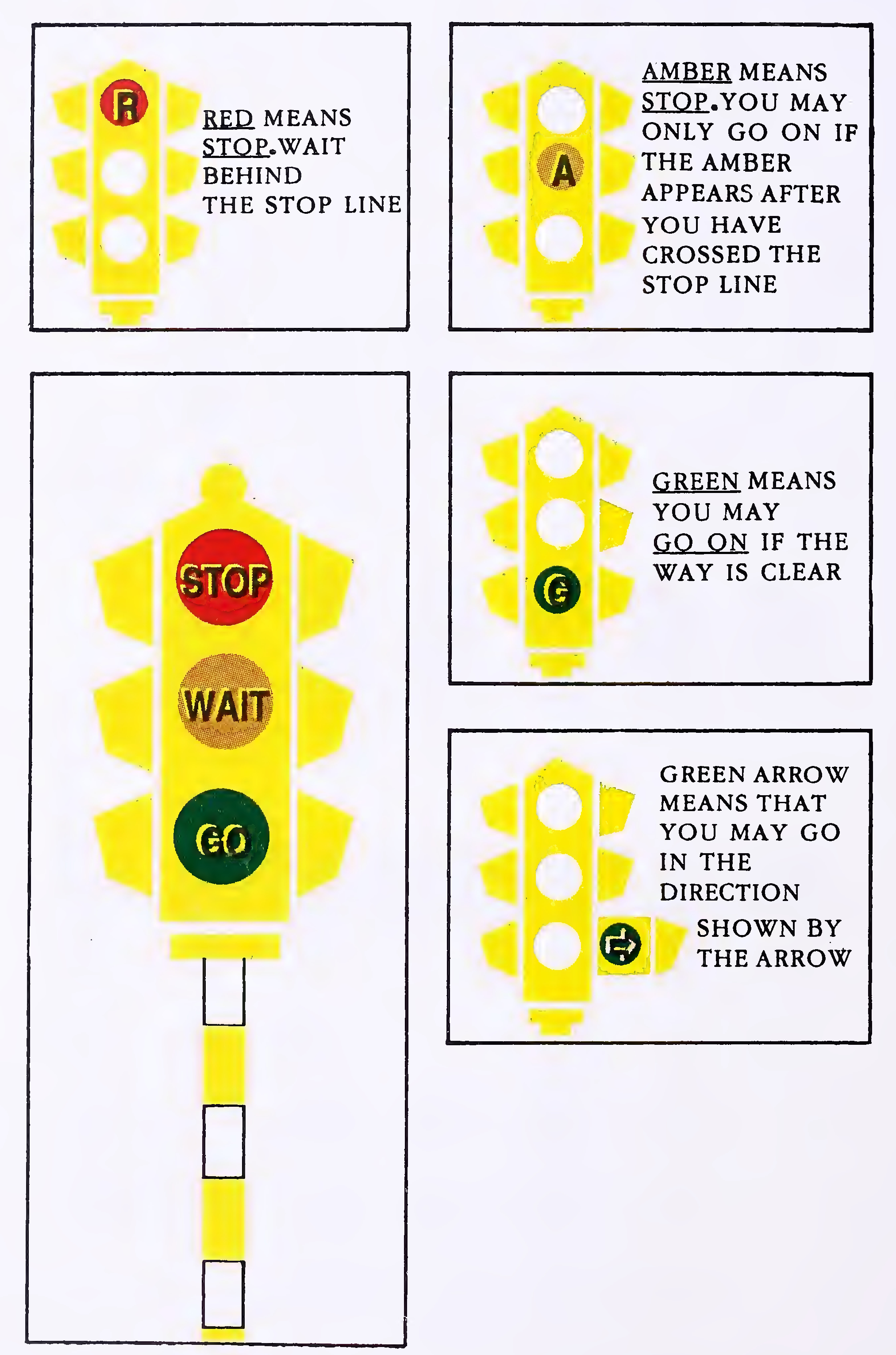
Fig. 3. Traffic Light Signals10

Fig. 4. Pedestrian Signals

Fig. 5. Lane Use Control Signals12
Most roads have pavement markings to delineate the centre of road, identify travel lane, define road edge. Pavement markings also provide information about special lane use. Markings can also be in the form of patterns, arrows, or other devices set into or attached to the carriageway or kerbs or to objects within or adjacent to the carriageway, for control, warning, guidance or information of road users.
Generally white/yellow lines separate traffic moving in opposite directions. White lines divide lanes of traffic moving in the same direction. As a general rule broken traffic lines can be crossed while solid lines cannot be crossed.
Examples of common pavement markings and their meaning are given hereinunder (see Figs. 6 to 8).
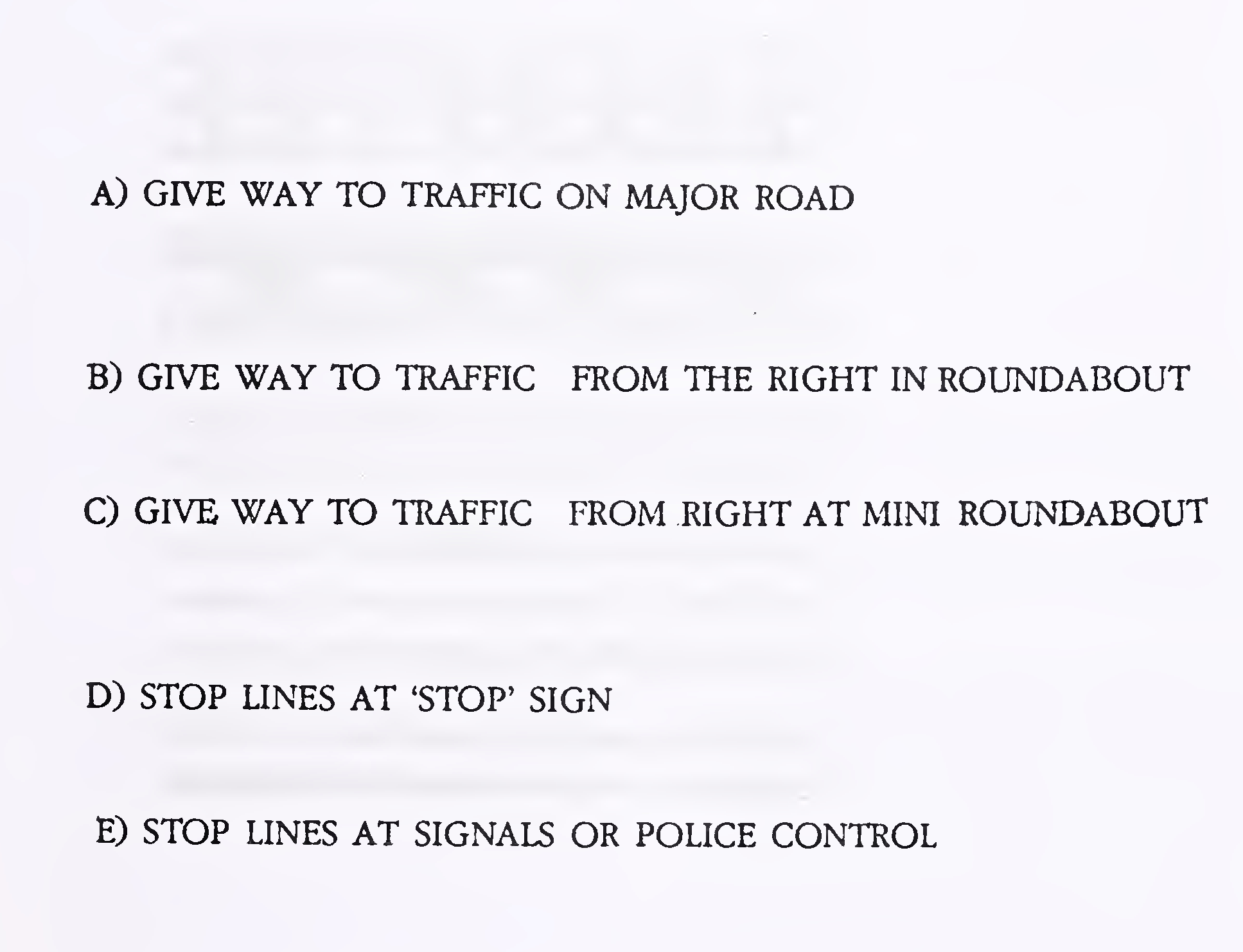
Fig. 6. Road Markings Across the Carriageway
Lines across the carriageway (see Fig. 6)
words or a triangle painted in advance of the lines.

Fig. 7. Zebra Controlled Area

Fig. 8. (a) Centre Line14
for overtaking, unless one can see that the road is clear well ahead. Special care be exercised when overtaking.

Fig. 8. (b) Double White/Yellow Line
where traffic is flowing in both directions. Where provided overtaking is not permitted in either direction. Vehicle must not cross or saddle it except when needed to get in and out of premises or a side road, or when ordered by a policeman to cross the line or when needed to avoid a stationary object.

Fig. 8. (c) Combination or Solid and Broken Line
yellow lines also defines the centre of a two way road. Passing is permitted for vehicles with the broken line on the edge of their line. Vehicles may not overtake when a solid white/yellow line is next to their lane.15

Fig. 8. (d) Multi Lane Marking
divide the road into lanes. Vehicles are required to drive between these lines. Keep to the left lane except while overtaking or turning right or passing a parked vehicle. Where the extreme left lane is used by slow moving traffic, fast vehicle should keep to the middle lane.

Fig. 8. (e) Diagonal Stripes
diagonal stripes or white chevrons, painted on the road are to separate traffic streams. Do not drive over these areas if you can avoid doing so.
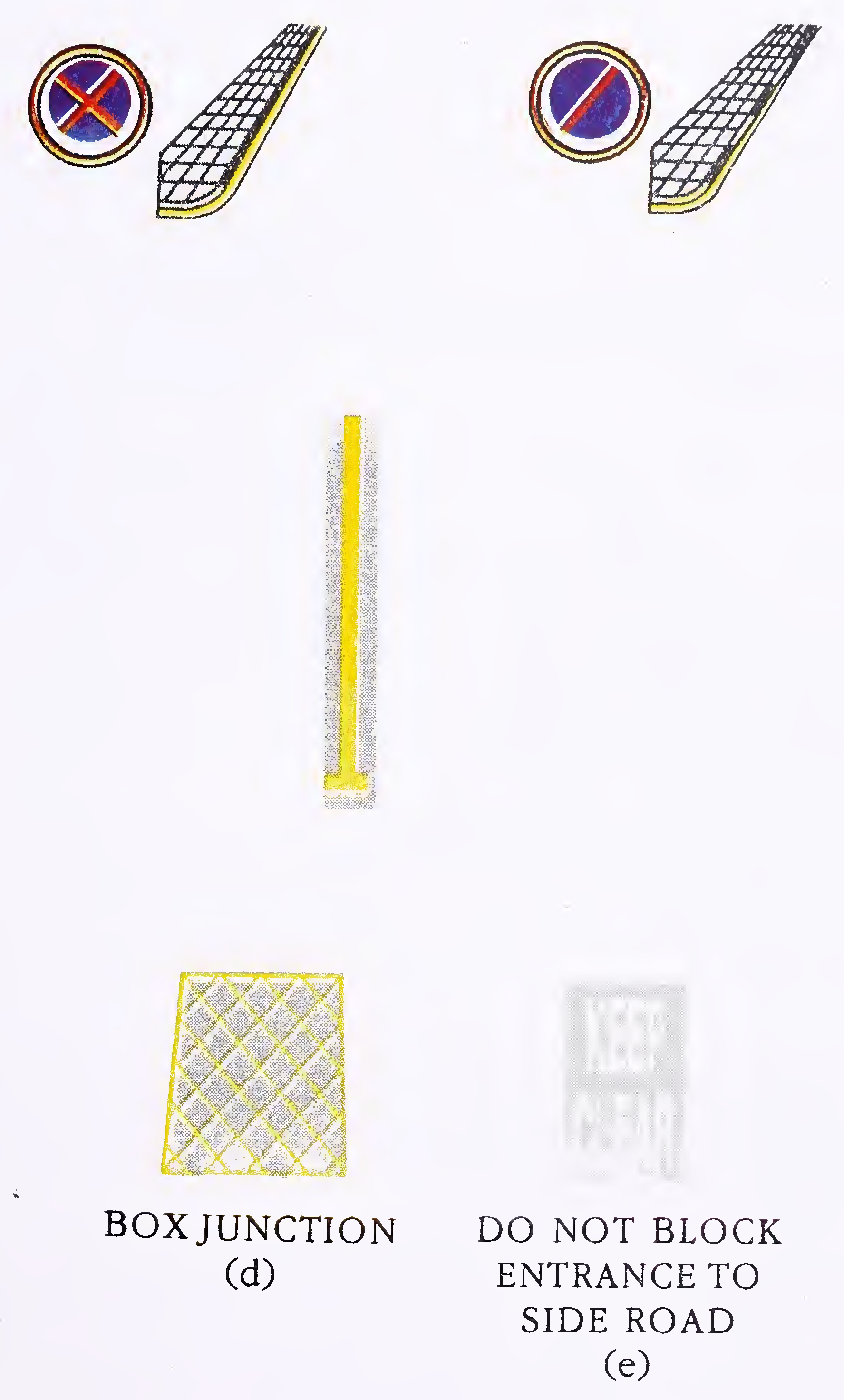
Fig. 9. Pavement Markings17
Pedestrians form a major part of road users in India. They are also the most vulnerable group in terms of their involvement in fatal accidents and serious injuries. This Code has been framed with the basic objective of providing guidelines for safe travel on roads and is based on research done throughout the world on safety for pedestrians. Meticulous compliance of these guidelines can go a long way in promoting pedestrian safety.
Where there is a designated Kerb footpath or shoulder of sufficient width, pedestrians are required to walk on these.
If there is no Kerb footpath, or designated shoulder, the pedestrians must walk close to the right side of the road such that they are facing the oncoming traffic and can see it (see Fig. 10). Pedestrians must keep as close to the side of the road and not walk more than two side by side. They must keep one behind the other if possible, particularly in heavy traffic or in poor light and at corners.
Children, upto the age of seven at least, should not be allowed alone on the road. Elders must accompany them and they must keep themselves between the traffic and the children. They must always keep tight hold of their hands and must not let them run into the road.
Pedestrians must always wear or carry white or light coloured clothes or vests with reflective tapes in the dark or in poor light. Reflective materials can be seen in headlights at upto three times the distance compared to ordinary clothes, but fluorescent materials are of little use in the dark.
Blind persons walking along a road at night must carry one cane/stick painted with reflective paint or fixed with reflective tapes of sufficient width and preferably wear vests with reflective tapes fixed on it. Wearing of bright clothes is a must.
A group of people marching on the road (e.g. returning from work at night) should keep to the left. There should be lookouts in front and the backs wearing reflective clothings at night and fluorescent clothings by day. At night the lookout in front should18

Fig. 10. Walk Facing the Traffic & Keep Children Away from Traffic Side
carry a white light and the one at the back a bright red light visible from the rear. Additional lights should be carried by people outside of the long column.
Pedestrians are prohibited from entering or crossing on the Expressways and their slip roads.
The pedestrian must cross the road on an intersection with traffic light nearby. All efforts should also be made to use pedestrian foot bridge or underground pedestrian subway if they are within reasonable distance. Otherwise cross under a street19
lamp where you can be seen (see Fig. 11). It is extremely dangerous to jump guard rails and cross the road at such places (see Fig. 12).
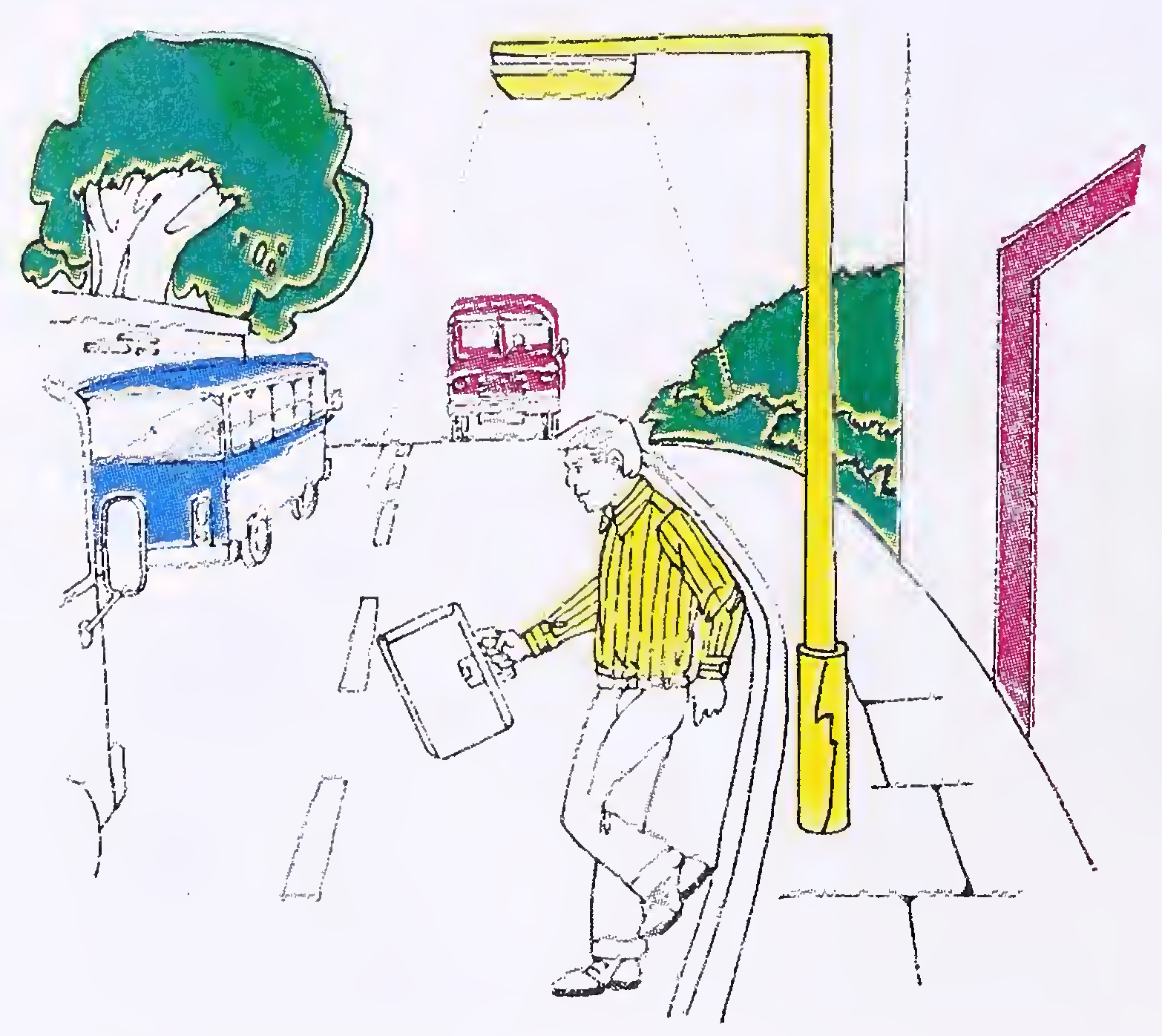
Fig. 11. During Night Cross Underrneath a Street Lamp

Fig. 12. Do not Jump Over the Guard Rails or Walk on the Carriageway Side20
If there is no designated crossing place nearby, choose a place where you can see clearly along the road in all directions. Do not try to cross between parked vehicles. Move to a clear space and always give drivers a chance to see you clearly and well in time. Then follow the following “Kerb Drill”:
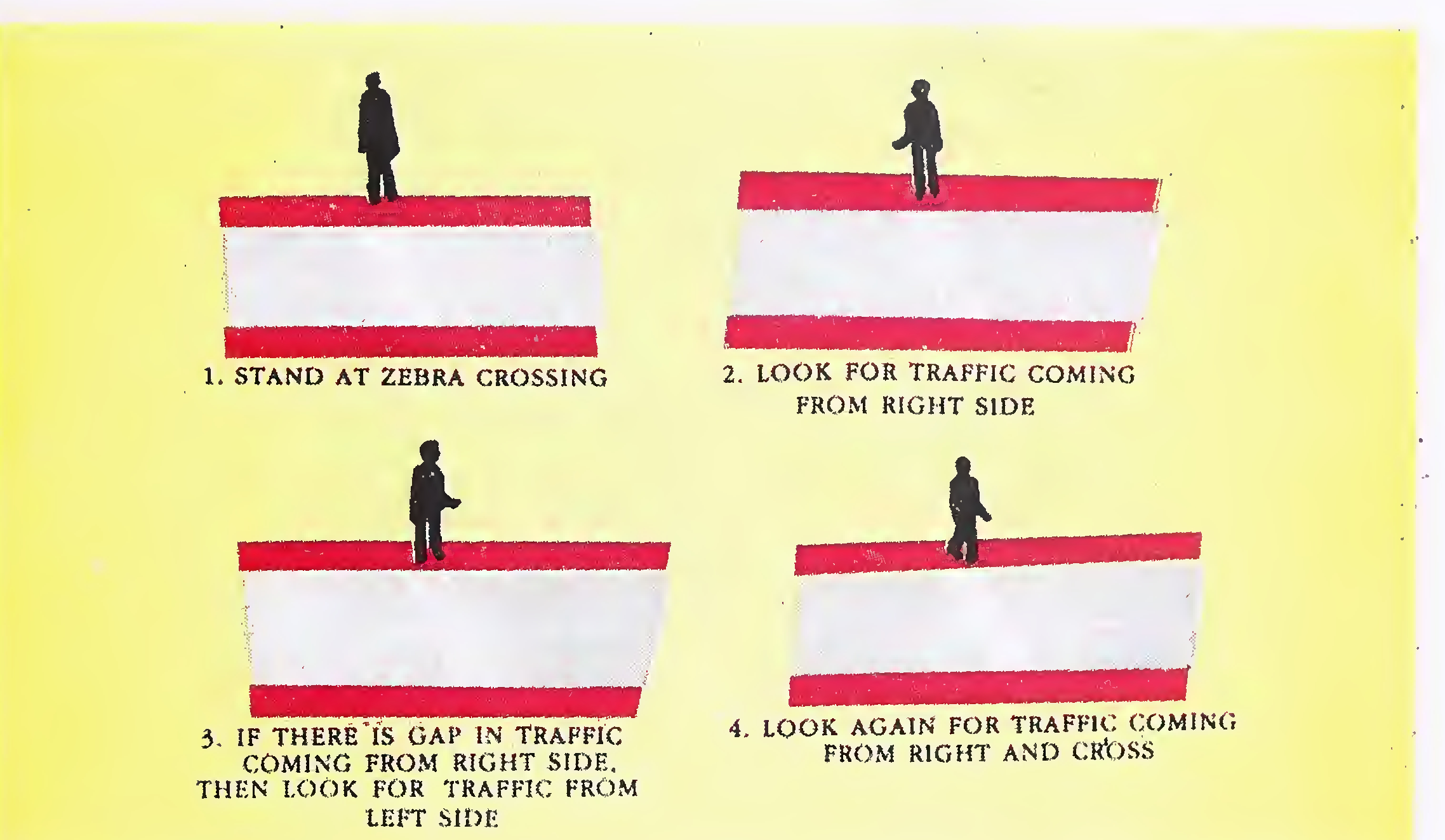
Fig. 13. Kerb Drill
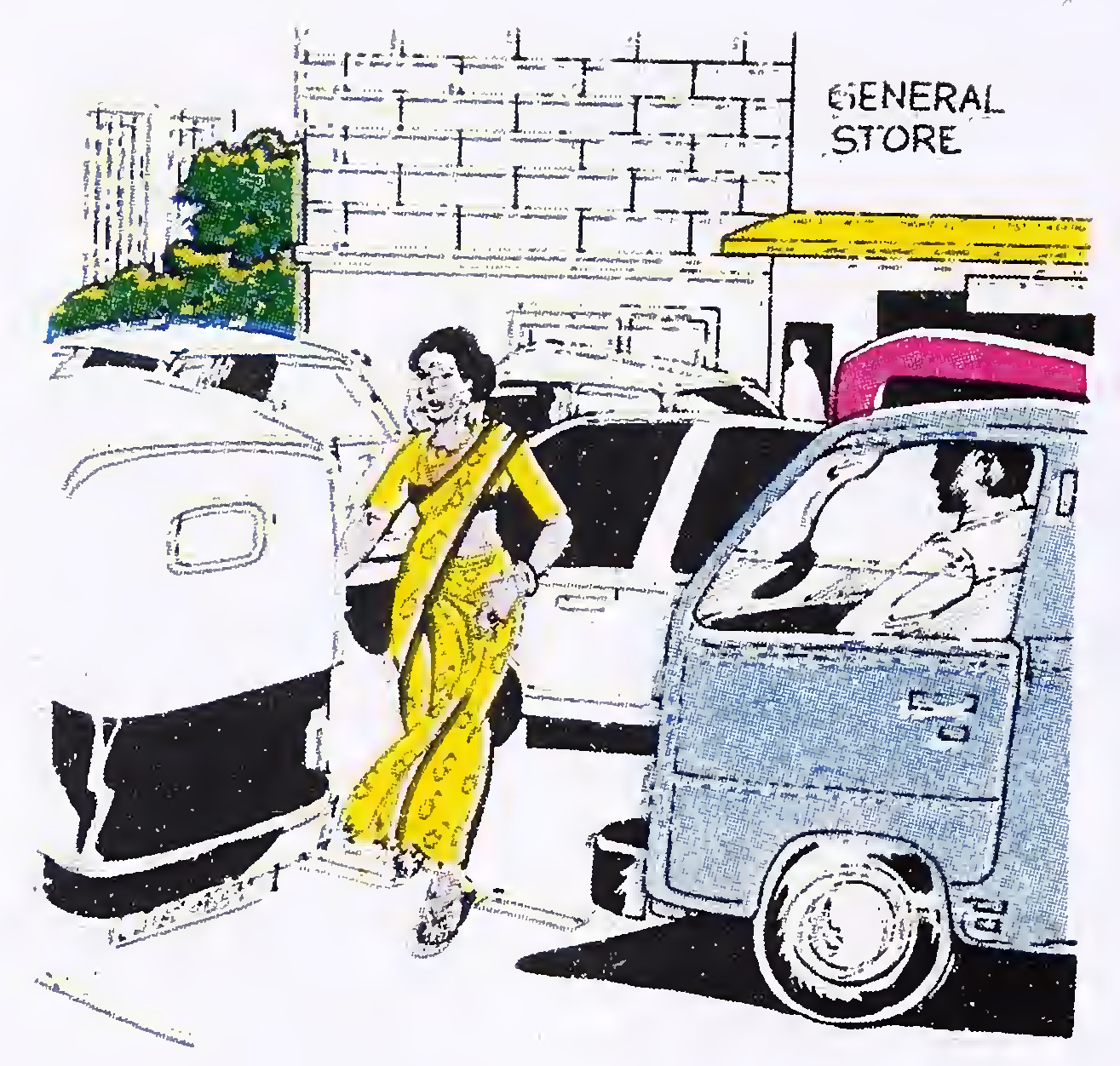
Fig. 14. Do not Cross Between Parked Vehicles
allow traffic to proceed in some lanes while other lanes are stopped.
If guard rails are provided, do not jump over them to cross the road but use only the gaps provided. Do not walk on the roadside of the guard rails (see Fig. 12).
The convention for zebra crossing is that once a pedestrian has entered a zebra crossing, he gets priority over other traffic. This convention also implies that, before stepping on the zebra crossing, the pedestrian should see that there is no vehicle approaching the zebra crossing immediately and to allow sufficient distance and time to any approaching traffic to stop before reaching the zebra crossing. However, in our country, this convention is not enforced and many vehicle drivers are not educated about this. As such, even while attempting to cross the road on a zebra crossing, it is imperative for pedestrians to see that the carriageway is clear, for a sufficiently long distance of vehicular traffic to enable them to cross over safely. Even if this convention comes to be accepted widely by the motorists, the advisability of the pedestrians keeping proper watch and care for their own safety cannot be over stressed.
If there is a refuge island in the middle of the zebra crossing or at uncontrolled intersections, road-way on either side of the island should be treated separately and kerb drill followed for crossing the road.
Do not cross the road if the police or any other officer, e.g., traffic warden or member of the school traffic control squad, controlling the traffic, is allowing traffic to move and has signalled you to stop.
Do not alight or board a moving bus or even a stationary bus unless it is standing on a recognised bus stop. If you want to get in a bus at a “By request” bus stop, give a clear signal for the bus to stop and do not try to get in unless the bus has stopped.
When you get off a bus and want to cross the road, wait until the bus has moved off and you have a clear view of the road. In case the bus seems to be taking a long time in moving off, do not cross the road in front of the bus but come to its back, perform23
your kerb drill and cross only when it is safe to do so (see Fig. I5)
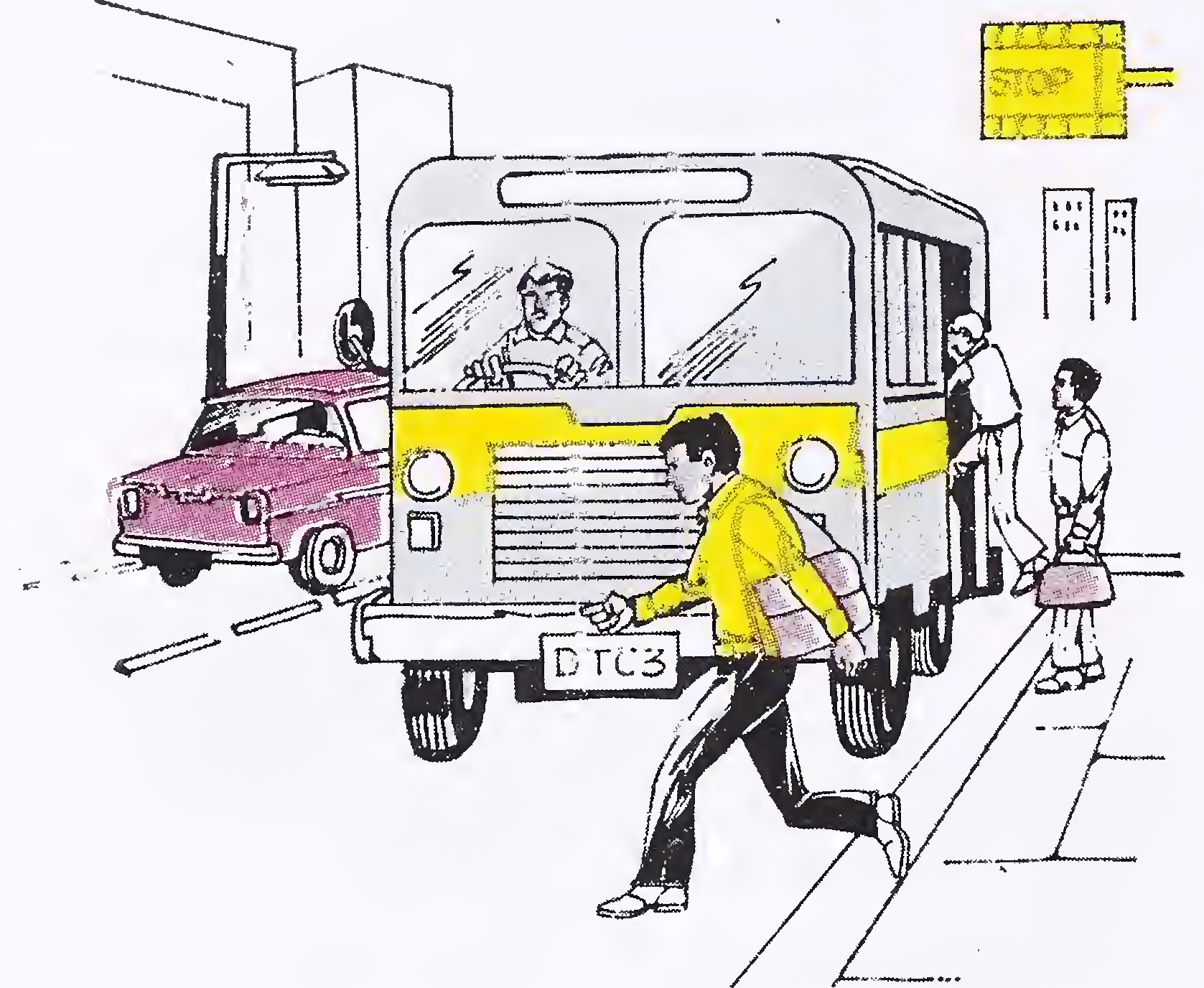
Fig. 15. Do not Cross Over from in Front of a Bus at a Bus-Stop
Do not board a bus which ,is so full that some portion of your body remains outside its frame work (see Fig. 16)
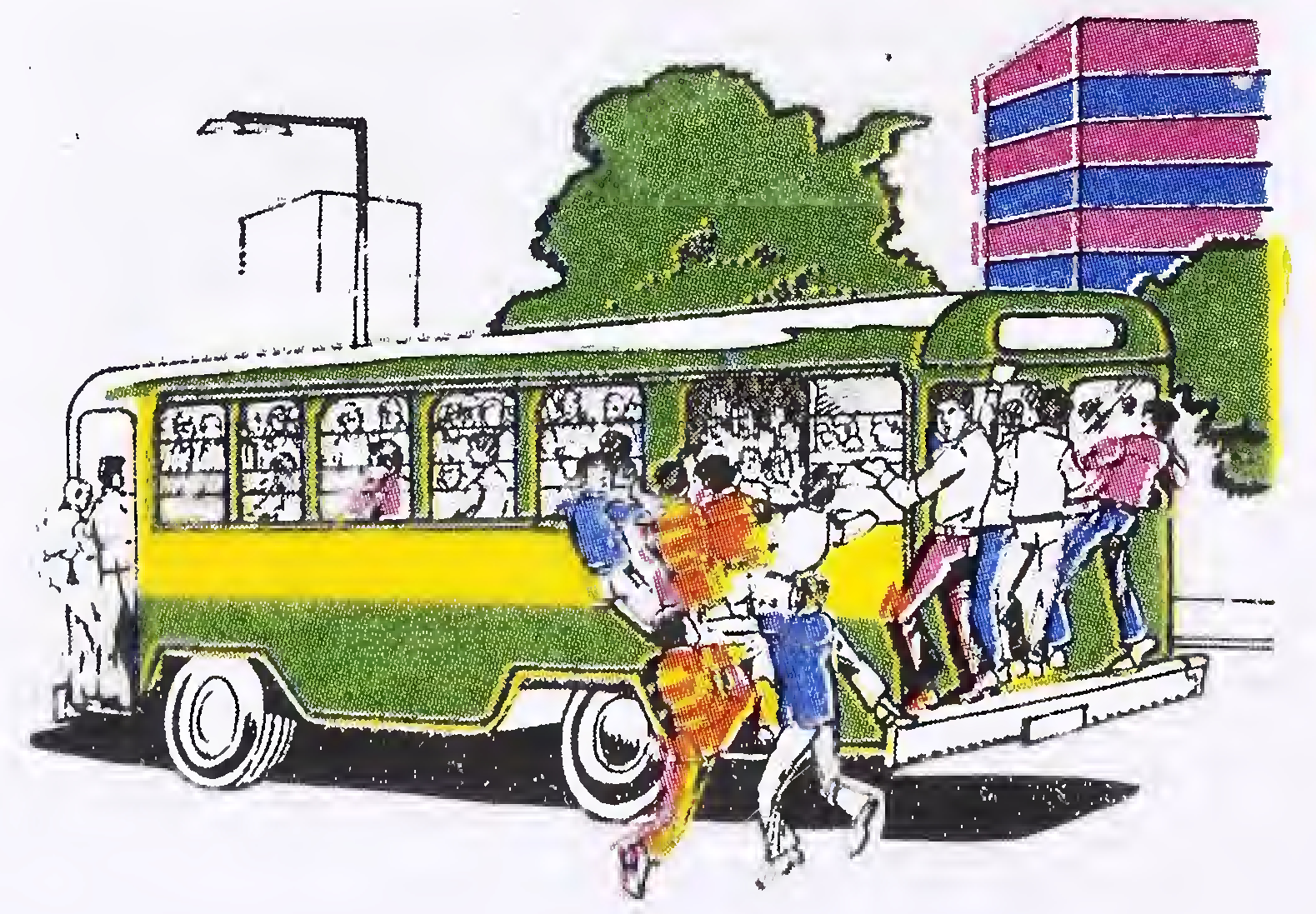
Fig. 16. Do not Board an Over-Crowded Bus24
Pedestrians should clear off the road and stand on the side on seeing or hearing an ambulance, a fire engine or police or other emergency vehicle approaching with its lamp flashing or hear a two tone horn or siren sounding.
At night, the vehicle drivers are prone to get momentarily and partially blinded by the headlights of an approaching vehicle. As a result, while the pedestrian can see the headlights of a vehicle, the driver cannot see the pedestrian. It is, therefore, extremely dangerous to stand in the middle of the road between traffic lanes for crossing at night. You must, therefore, first start crossing only if you can cross all the lanes in one go. Secondly, you must cross at a place where the area is well lit so that your presence is conspicuous to the approaching traffic. Thirdly, you must wear light coloured clothings and attach reflectors to your clothing, attache case, cane or shoes.
Visibility from vehicles is reduced due to rain in a similar way as at night. Road surface becomes slippery and walking and stopping distance of cars and other vehicles increases. When raining, pedestrians also run the risk of slipping and falling. Pedestrians must not, therefore, block their vision by umbrella and leave plenty of time for crossing. Avoid sprint across the road.
Many pedestrians fatalities occur at railway crossings. Do not cross when the crossing gate has begun to fall. Do not try to squeeze under the gate to cross. Stop on the side if you hear or see the train approaching. Do not take any risk as the crossing area may be rough and you may fall on the track
Pedestrians are prohibited from standing on a highway to solicit employment, business or contribution from the occupant of any vehicle. Pedestrians are not allowed to stand on or next to a highway to solicit the watching or guarding of any vehicle25
while parked or about to be parked.
Pedestrians should not cut corners and try to save time by crossing the road diagonally.
Animals individually or in herds should not be left on the road or roadland. It is not permissible to use roadside land for grazing or exercising animals.
If you are herding animals along a road, keep the animals to the left side of the road and leave sufficient passage for plying of vehicles. If the herd is large, more people must accompany it and it should be spaced out longitudinally so as not to block the road, the herd should be guided along so as to prevent animals straying into vehicle path.
Before riding a horse, elephant or a camel on the road, make sure you can control it in traffic and that it does not get out of control due to blowing of horn or traffic noise. When riding an animal, keep to the left and when leading it keep it on your left. On oneway streets, proceed only in the direction of traffic and keep to the left. Follow the road rules and signals.
Do not let any animal loose on the road whether it is a dog, cow, buffallo, horse, elephant or a camel. Animals must be kept on leash and should not be allowed to wander about on the road or allowed to graze along it.
Slow moving and animal drawn vehicles should move on the extreme left of the road and must give proper and timely signal when changing lane. It is the duty of the driver to look behind and see before turning. Turn only if the lane is clear or there is sufficient gap in the traffic.
Goods loaded on slow moving vehicles should not protrude on the side, back or front. If long articles, such as girders or poles are being carried, a red flag at the end should be displayed. At night a red lamp of a reflector should be displayed at the rear end (see Fig. 17).26
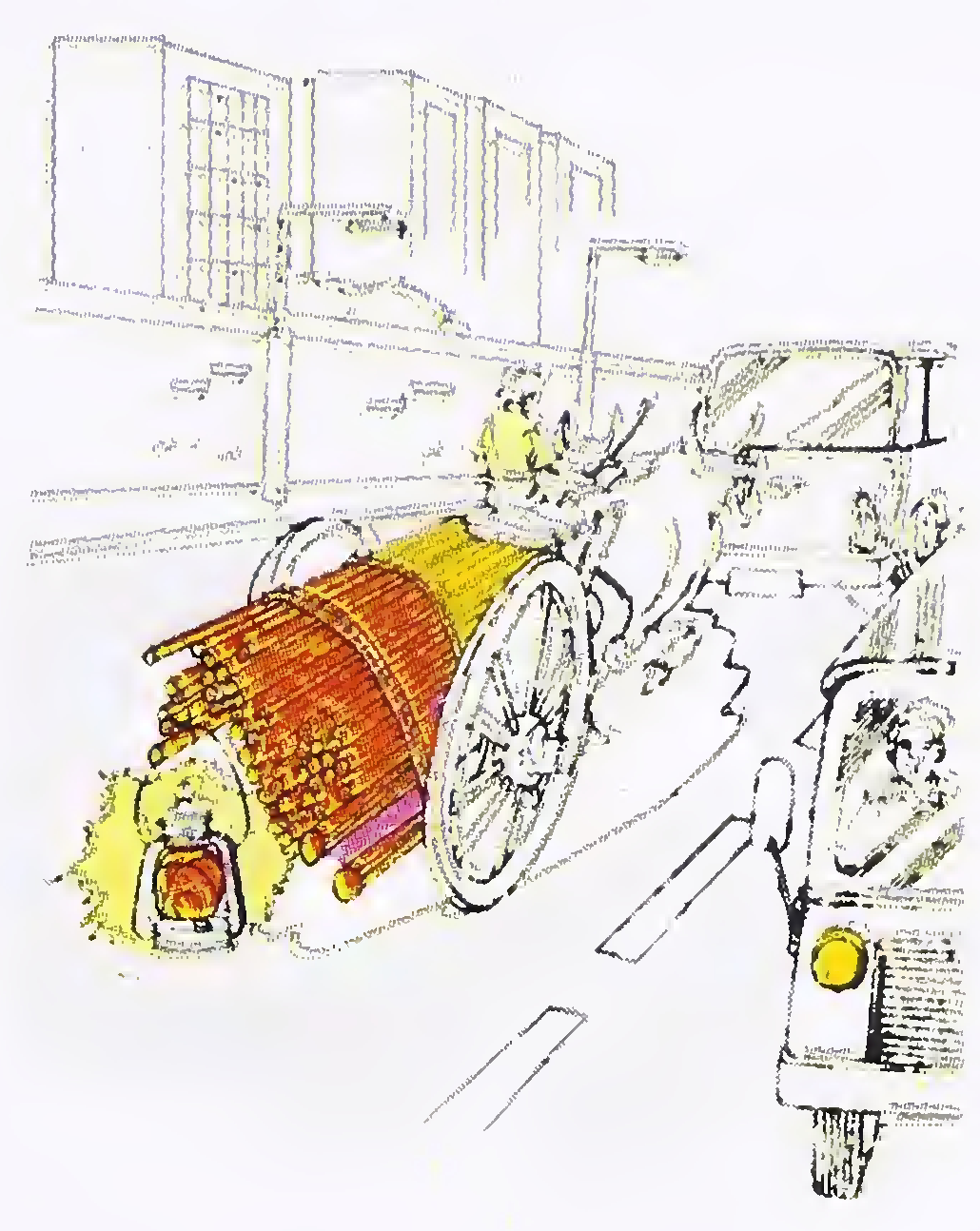
Fig. 17. At Night, have a Lighted Red Lamp at the Extreme Point of Projected Load on Bullock-cart
At night all such vehicles should have a lamp showing white light in front and another showing red light (See Fig. 18) at the back. Adequate reflectors or reflective sheeting

Fig. 18. Do not Sleep in your Bullock-cart while it is in Motion27
should be fixed on the rear portion of such vehicles and remaining portion painted white.
Before getting on your bicycle (see Fig. 19) be sure to check out the following and do not get on the road if any one of these checks is not satisfying:
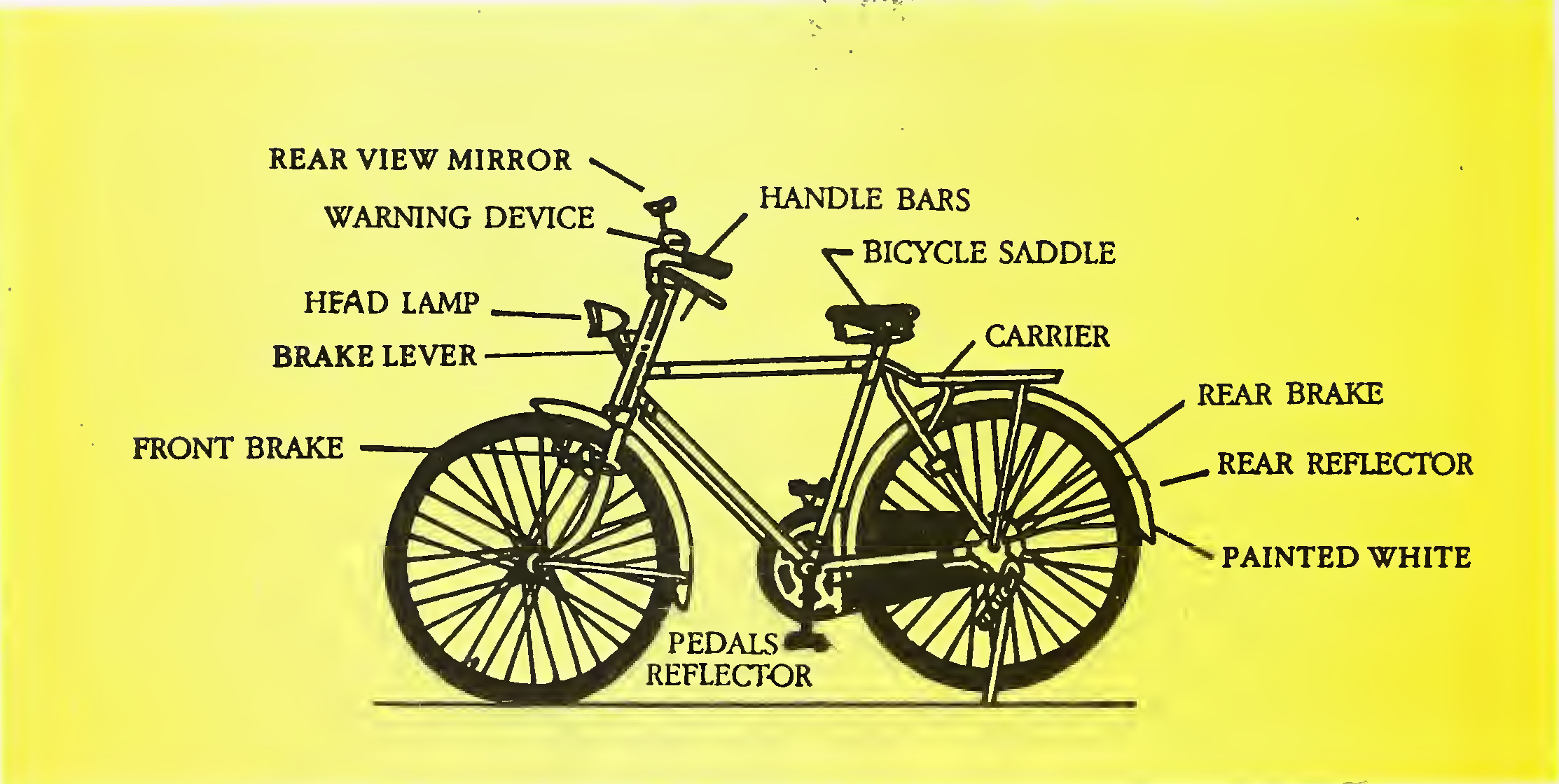
Fig. 19. The Typical Bicycle
Your cycle should be visible at night and be conspicuous during the day. For this purpose the front and rear guards should be painted yellow and orange or provided with reflectors. Pedal edges and rear should be provided with reflectors. You should also wear fluorescent yellow/orange vest with reflectorised tapes stitched in a suitable pattern.
Before starting to ride, find a place in the road that offers good vision and enter the traffic from the left side after having carefully looked both ways.
Before turning right or left or moving out to pass or pulling up, always glance back or look through rear view mirror behind and make sure it is safe. Give a clear arm signal to show what you intend to do (see Fig. 20).
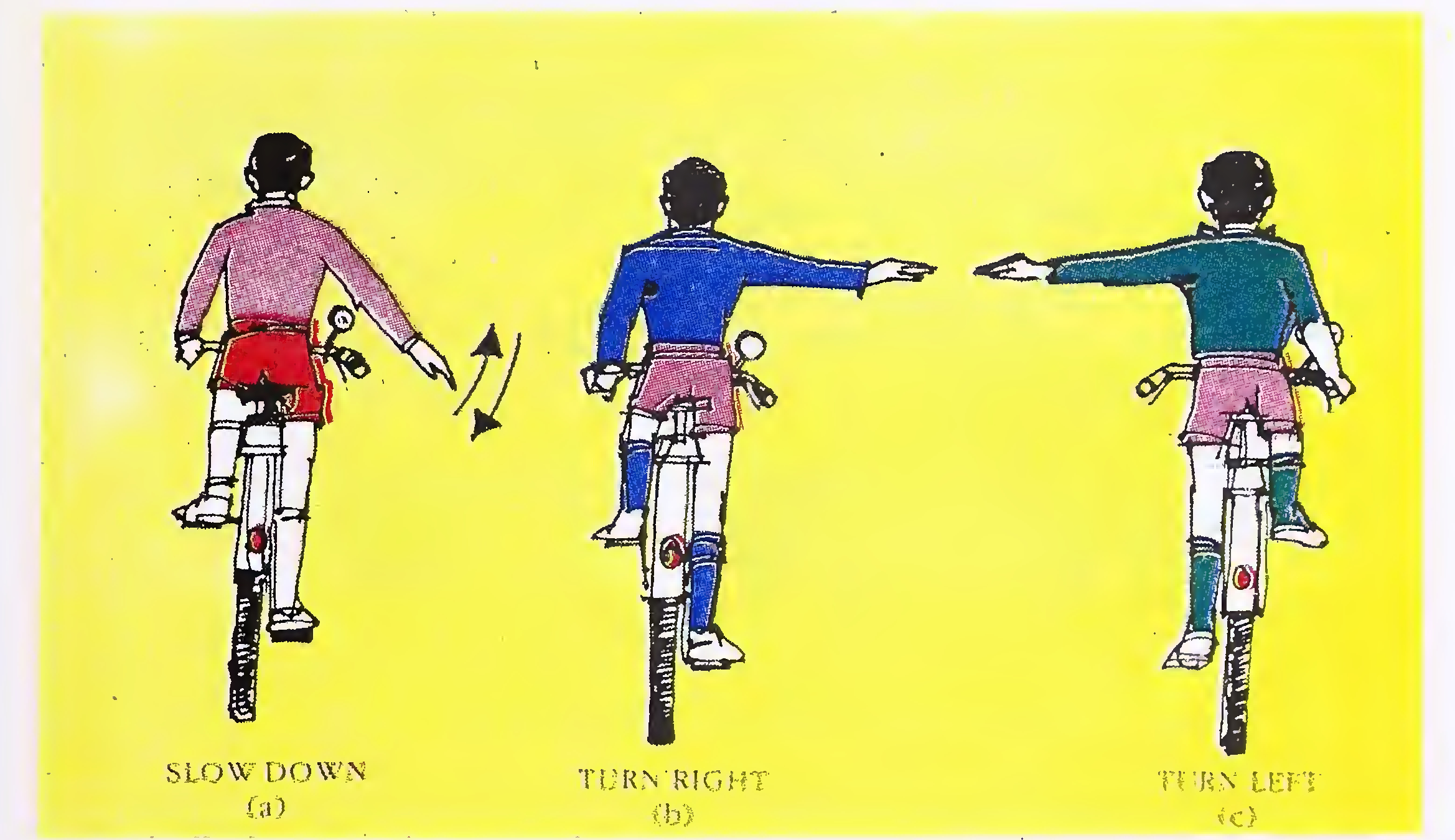
Fig. 20. Arm Signals
If you want to turn to the right, move to the extreme right of the road and wait for a safe gap in the traffic in both directions29
before you start to cross.
On busy roads and at night, if you want to turn right it is safer to stop on the left hand side of the road, wait for a safe gap in the traffic and then start to turn.
Do not ride more than two side by side. Ride in single file in busy or narrow roads. Do not ride on a footpath.
At a road intersection with traffic lights when the signal is against you, do not zig-zag your way to the front of the waiting queue of the vehicles.
While riding, observe the following:
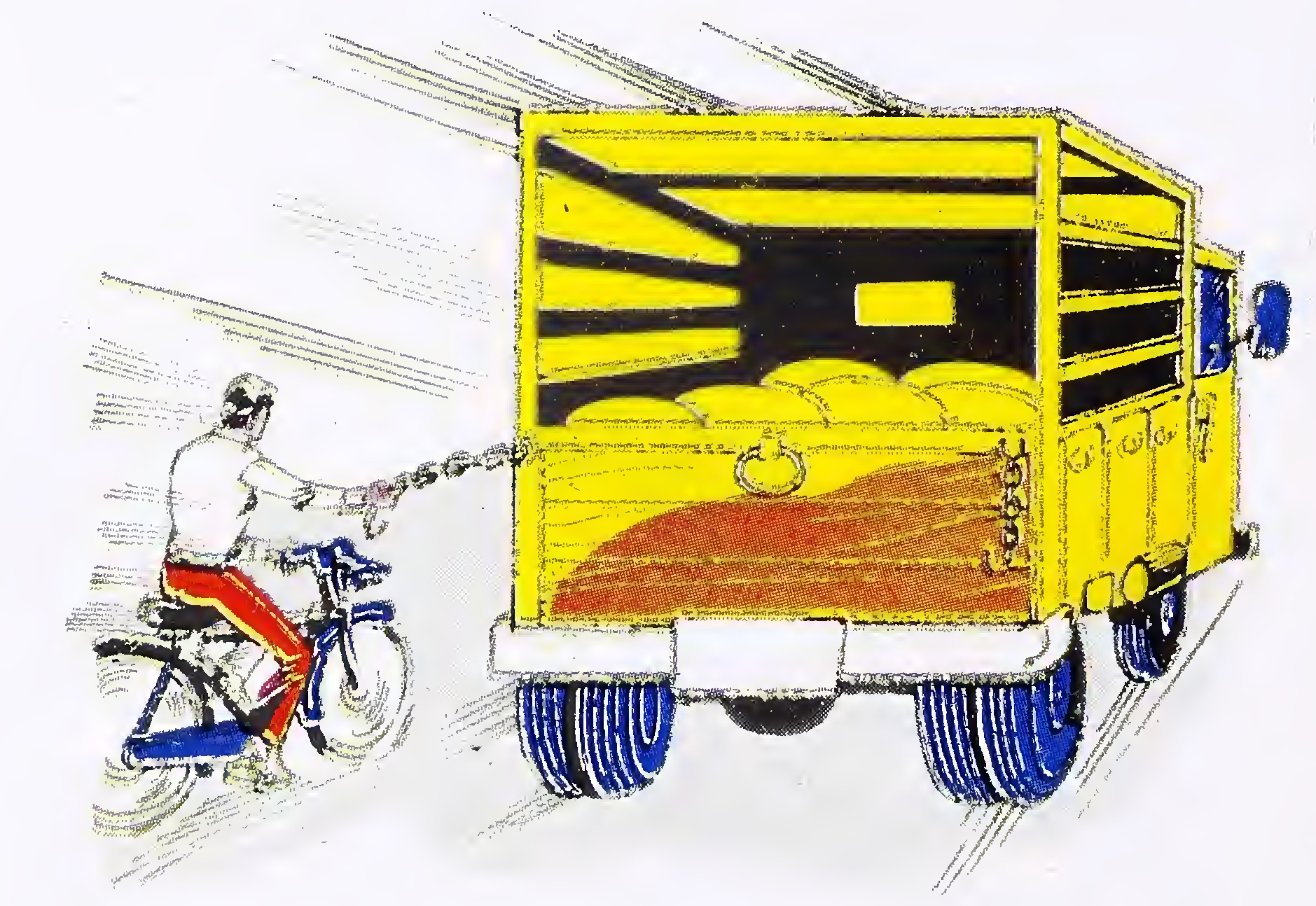
Fig. 21. Do not hold to a Faster Vehicle

Fig. 22. Do not Overload Your Cycle
If a separate cycle track is provided, do use it instead of using the main carriageway.
Do not enter into speed competition with any other cyclist or vehicle on the road.
Be on the defensive rather than dashing. Do not indulge in any form of trick cycling on the road, which is not the correct place for it.
Gain familiarity with the rules of the road, road sighs and markings. These are applicable to you also.
It is dangerous to have two people on a bike in heavy traffic. Even where there is little traffic, two on a bike should be avoided. Where there is a holding seat, it is permissible for a child to be carried.31
Do not attempt to ride with loose fitting shoes or clothings which will hinder or clog the pedals, wheels or the chain.
Do not ride holding an open umbrella. It is dangerous to ride with a dog or other animal running along on a rope or chain. Things should not be carried by the hand and hung down from the handle bars.
Remember that you should be seen as easily as a larger vehicle and that you should always give clear arm signal to let drivers behind you know what you intend to do especially at roundabouts and intersections. Always look behind before making any change in direction and do so only if it is safe.
At night and also inside tunnels and on foggy days, keep the light turned on. Should you be momentarily blinded by lights of approaching vehicles, pull over and stop at the far left side of the road and wait for a few seconds until the car has passed and vision has recovered.
Should your vehicle brakes or lights go out of order, walk along side the bike pushing it with your hands. Do the same if road surface is extremely slippery and there is a lot of wind, dust or rain.
There are many bicycle accidents in which a bicycle moving along the far left of the road gets hit by a car or truck as it makes a left turn (see Fig. 23). When intending to continue straight at such intersections take special care to look out for the position and speed of vehicles turning to the left.

Fig. 23. While Turning left look for Safety of the two Wheelers/Animal drawn Vehicles
green.
Motorised vehicles are the most lethal of those using the roads and the responsibility rests on its drivers to protect the other users especially the pedestrians, cyclists and two-wheeler drivers. Meticulous compliance of the rules given here would reduce the risk of your getting involved in accidents.
Do not drive when you are tired, worried or if you have taken medicines for allergy, cold, headache etc., that induce drowsiness. In such conditions your power of concentration and ability to act decisively gets impaired rapidly and chances of traffic accidents increase. It is against the law to drive under the influence of alcohol, drugs, stimulators, etc.
you as well as for on-coming traffic and no one has exclusive right of its use.
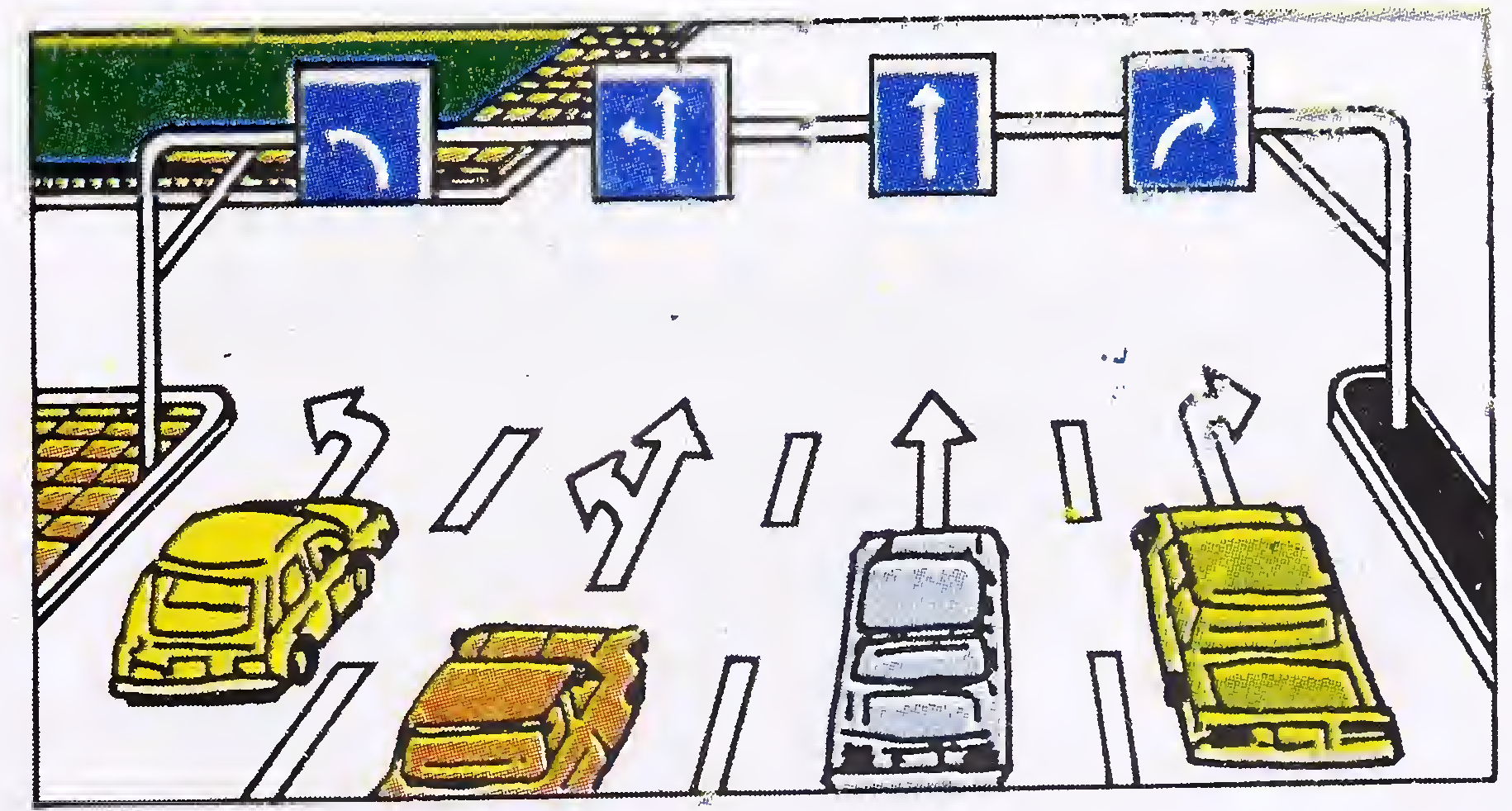
from one lane to another, even if the traffic in your lane has slowed down.
If another driver makes a mistake, you need time to react. The only way you can be sure, you will have enough time, is to leave plenty of space between you and the vehicles around you. Try to drive in the middle of a lane and keep a cushion of space on all sides (see Fig. 25).
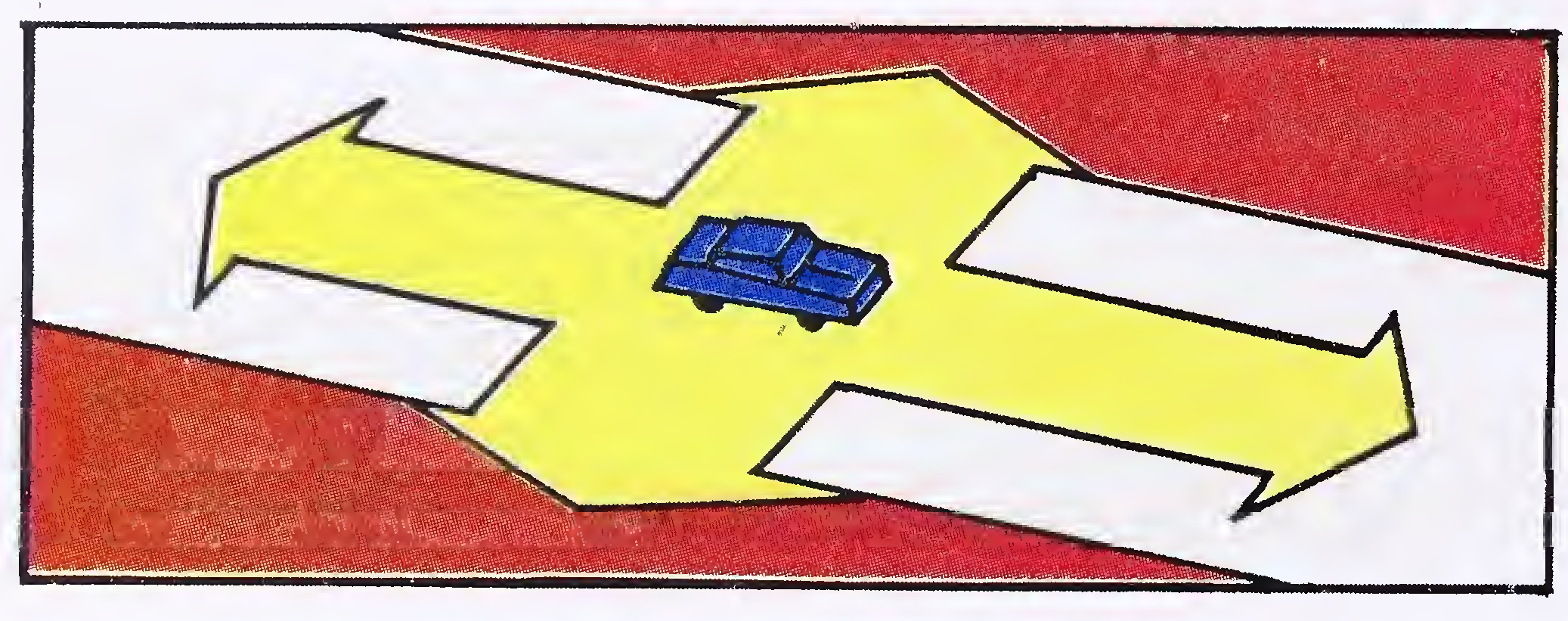
Fig. 25. Vehicle Space Cushion
(1) Do not follow the vehicle ahead too closely; if the vehicle ahead stops or slows down suddenly, you will not be able to stop in time. Before a car stops, it covers a reaction distance from the time when the driver first senses danger, applies the brakes to when the braking action first comes to take place. In addition, there is the braking distance covered in the time from when the braking action first begins to take place to when the vehicle actually comes to a halt. These together make stopping distance and is given as a function of the driving speed in Table-1.36
|
Speed
(km/ph) |
Brake reaction time distance
(metres) | Braking distance (metres) |
Total safe stopping distance (metres) |
|---|---|---|---|
| 20 | 14 | 4 | 18 |
| 25 | 18 | 6 | 24 |
| 30 | 21 | 9 | 30 |
| 40 | 28 | 17 | 45 |
| 50 | 35 | 27 | 62 |
| 60 | 42 | 39 | 81 |
| 65 | 45 | 46 | 91 |
| 80 | 56 | 72 | 128 |
| 100 | 70 | 112 | 182 |
It is desirable to keep the required stopping distances in mind and to drive at speed at which you can stop safely even when a dangerous situation suddenly arises.
(2) In situations where it is not possible to keep the aforesaid safe stopping distance between the adjacent vehicles, e.g. in urban/semi-urban areas under high traffic conditions, as a thumb rule for safety, a headway of atleast one car length for every 15 km/hour speed (as illustrated in Fig. 26) must be ensured.

NOTE : INCREASE THESE GAPS IN BAD LIGHT AND ON WET OR DUSTY ROADS.
Fig. 26. Safe Distance Between Vehicles37
(3) In some situations you need extra cushion. Allow a longer following distance when:
You also heed a space cushion in the lateral side, so that you have room to react when other cars make sudden move towards your lane. To help avoid accidents remember the following points:
Watch the road behind you by frequently glancing in your rear-view mirror. If the following vehicle is too close to you, give him opportunity to overtake you by moving carefully to the left. Maintain a steady speed and signal in advance when you38
have to slow down or change lane. Never accelerate while you are being overtaken. Look over your shoulder for vehicle overtaking in blind spot area (see Fig. 27).
Following order of operations will ensure safe overtaking of other vehicles:
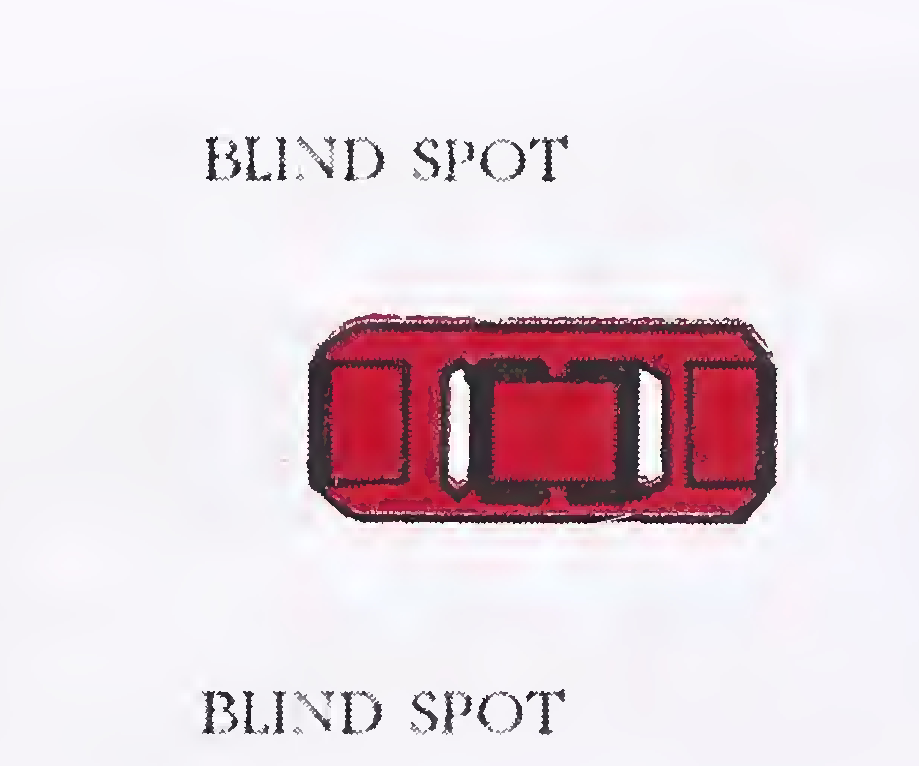
Fig. 27. Blind Spot Area39
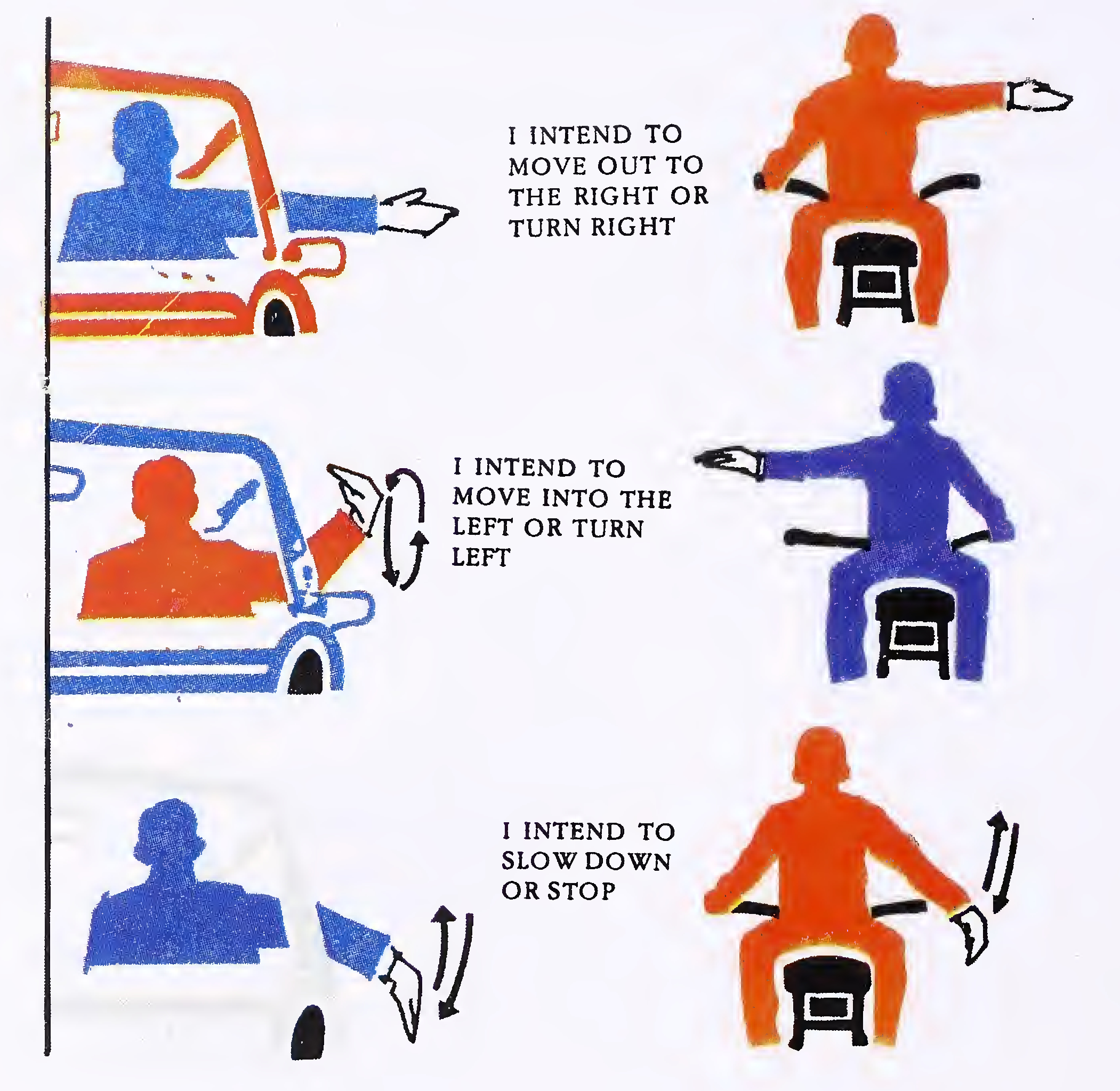
Fig. 28. Arm Signals
At that point you may slowly and smoothly move back into the lane you left behind (see Fig. 28).
When you are being overtaken, slow down a little so that the other vehicle may overtake without increasing its speed too much. In any case do not accelerate.
On an ordinary two-lane road, allow the on-coming vehicle to pass you before you overtake parked vehicles, slow vehicles or Other obstructions on your left side.
You must not overtake, if you have to cross or straddle double white lines or double white lines, with an unbroken line nearer to you or after “No Overtaking Sign” and till the end of restoration sign or in zig-zag area before zebra crossings.
Maximum number of accidents occur at intersections. Be very alert and cautious when approaching and negotiating an intersection. Consider your road position and your speed. Enter the intersection area when you are sure it is safe to do so and that you will not block it.
At an unsignalised intersection with double broken white lines across the road and/or with a “GIVE WAY” sign, you must let the traffic on the cross-road go by first and enter only if a gap is available. At an unsignalised junction with a “STOP” sign and a double solid white line across your approach, you must first stop at the line, wait for safe gap in the traffic and move only if a safe gap is available.
When there are road signs or pavement markings giving instructions on from which lane one should turn or what type of vehicle may turn etc., these instructions must be complied with. When making a left turn, take the left lane in advance. When taking a right turn go over in advance or close to the centre line of the road as possible. When you are intending to turn right at an intersection, if any other vehicle coming from opposite direction is in the process of going straight or turning left, even if you have arrived first, you must not obstruct the passage of that vehicle. At places showing like blue coloured compulsory turn signs, vehicle must turn compulsorily in the designated direction, even if you desire to go in another direction.
On roads where there are designated traffic lanes with arrows or other signs and pavement markings stipulating from which lane one is permitted to turn and in which direction, all turning and driving must be done in conformity with these stipulations. If the vehicle in front of you should give a signal to turn right or left or to change lanes in order to travel or a traffic lane designated by road sign or pavement markings, you must not hinder that vehicle’s effort to change lanes.
[see Fig. 9(d)] Box junctions have crisscross yellow lines painted on the road. You must not enter the box if your exit road or lane from it is not clear. But you may enter42
the box when you want to turn right and are prevented merely by on coming traffic or vehicles wanting to make a right turn.
If you are going on a minor road and approaching an intersection with a major road, stop at the intersection, look around and wait for a safe gap in the traffic to negotiate the intersection. Traffic on the major road has a prior right of way but it has a corresponding duty to be careful about traffic from minor road. At intersections where the width of road seems to be uniform and there is no stop or give way sign, you must give way to vehicle coming from your right.
When there is a hold up in the traffic due to adverse signal, wait at your position in the queue and do not try to zig-zag your way to any position in the front.
If the signal shows green light, you have the right of way, but do not try to rush through the intersection for fear of change in the signal. Drive through the intersection cautiously, without undue hurry, and when you are sure it is absolutely safe. Never go forward beyond the “STOP LINE” if the signal shows an amber light Or an amber and red light together. Where traffic lights have a "LEFT TURN" green arrow filter signal, do not get into the lane where filtering is allowed unless you want to go in the direction shown by the arrow. Then also proceed carefully and give way to pedestrians.
When turning, slow down to a speed that enables you to keep control in case of emergencies and react to unexpected situations. It is important to be alert when turning. Watch out for pedestrians and other traffic. To complete a turn safely, three things are important: Signalling (see Fig. 28) positioning in proper turning lane and completing the turn in proper lane.
Sudden turns or lane changes cause accidents, so if you start through an intersection, keep going. If you start to make a turn, follow through. If you make a mistake, go on to the next intersection. You can work your way back to where you want to go.
On two lane two way road, make right turn from as close43
to the centre line as possible (see Fig. 29). Left turn should be made from or close to the left edge of the road as possible. On multilane roads start from the lane closest to where you want to go.
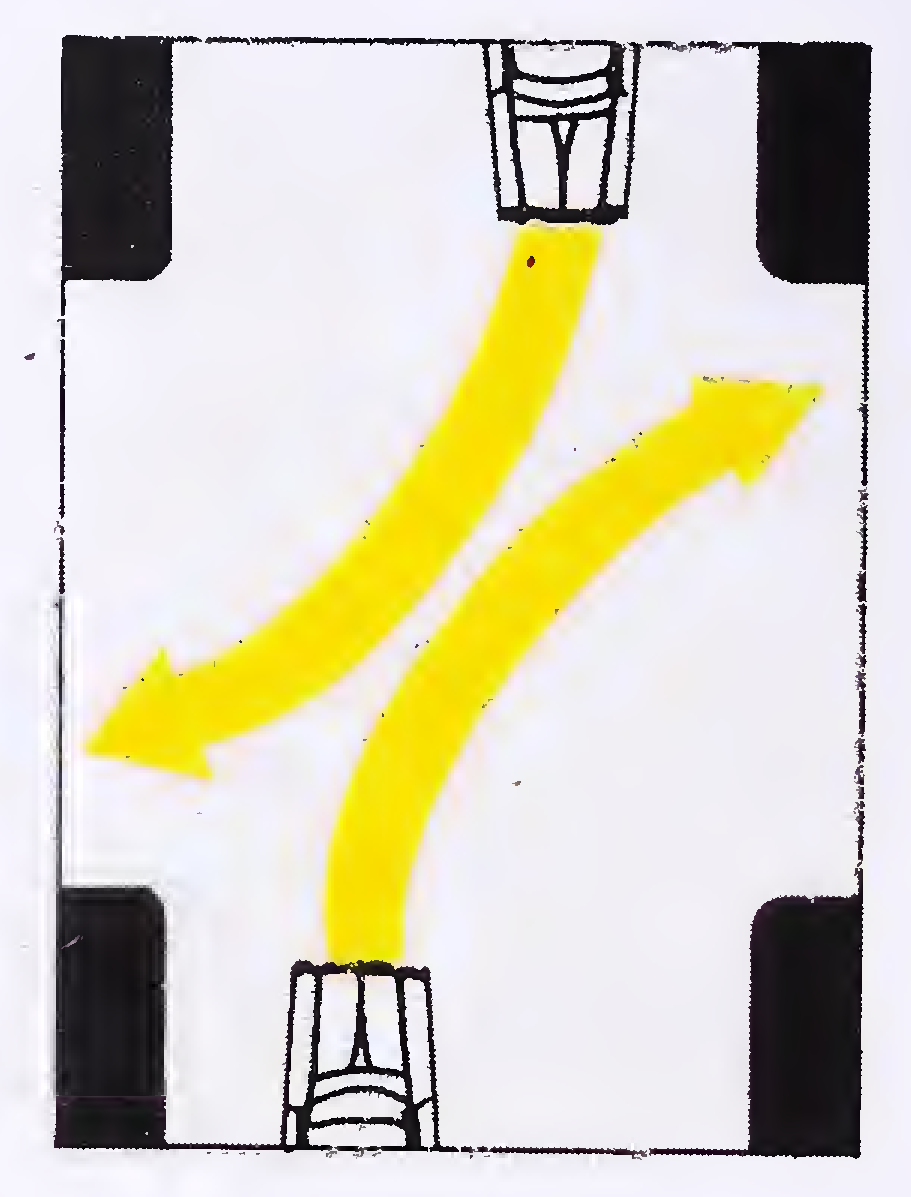
Fig. 29. Completing Turn in Proper Lane
If you are turning on to a road which has more than one lane in the direction you wish to travel, turn into the closest lane going in that direction. For example, turn into the right lane when making a right turn. If you want to change to another lane, move only after you have negotiated your turn and traffic is clear.
Well before you turn to the right, use your mirror to ascertain the position and movement of the traffic behind you. Give a right turn signal and when it is safe, enter the lane just left of the middle of the road or in the space marked for right turning traffic, the traffic behind you will now be passing on your left (see Fig. 30). Now wait for a safe gap in the oncoming traffic and when you find it, make the turn without cutting the corner. Remember again "MIRROR-SIGNAL-MANOEUVRE". When turning right on a dual carriageway or when turning in from a side road and then turning right, wait in the opening in the central verge until you find a safe gap in the traffic in the 'second half' of the road then cross over. When turning right at a junction where there is an opposing vehicle also turning right, drive your vehicle so that you keep it to your right and pass behind it (offside to offside). Check for other traffic on the carriageway intending to cross before completing the turn.
Well before you turn left, look into your mirror and give a left turn signal. You should be particularly careful44
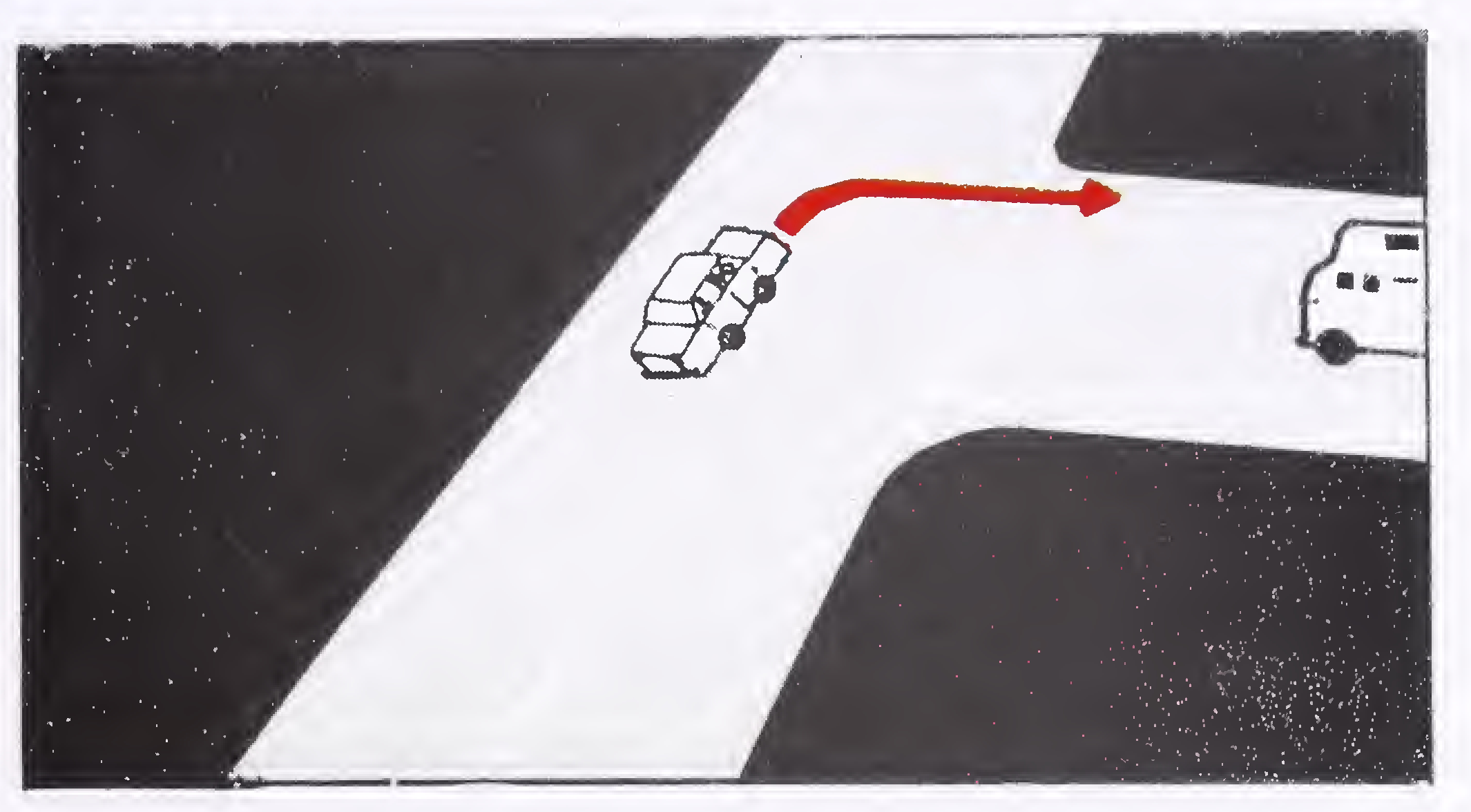
Fig. 30. Turning Right
about cyclists and other slow moving vehicles which are always confined to the left-most part of the road (see Fig. 31). If absolutely safe, move over to the left lane and take a turn smoothly without swerving to the right before or after the turn.
Make a U-turn if you can do so without endangering other traffic. If choosing a place to make a U-turn, make sure that drivers approaching from all directions can see you. Remember that crest of hill or a curve on the road can block another driver’s view of your vehicle. Do not make a U-turn where it is prohibited.
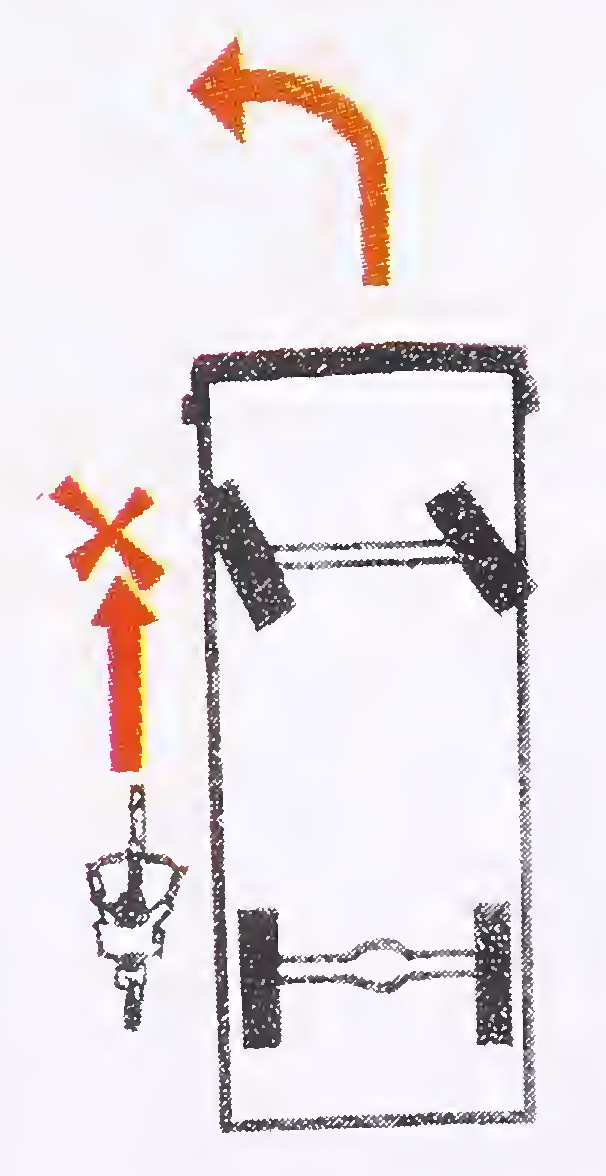
Fig. 31. Turning Left45
At a roundabout, the traffic coming from the right i.e. which is already in the roundabout has the prior right of way. Give way to traffic coming from your right (Fig. 32a) but keep moving if your way is clear. Unless the approach road on the roundabout itself are clear or local conditions, or road markings indicate otherwise, you should:
Moving with and through traffic demands skill that can be obtained only by extensive practice. The actual physical skills are relatively easy but the crucial judgement skills associated with the different vehicular movements require practice. But more important is understanding of the concept of right-of-way. The general rule is that you must give way to traffic coming from your right (see Fig. 33). The law does not give you an absolute right, it only requires46
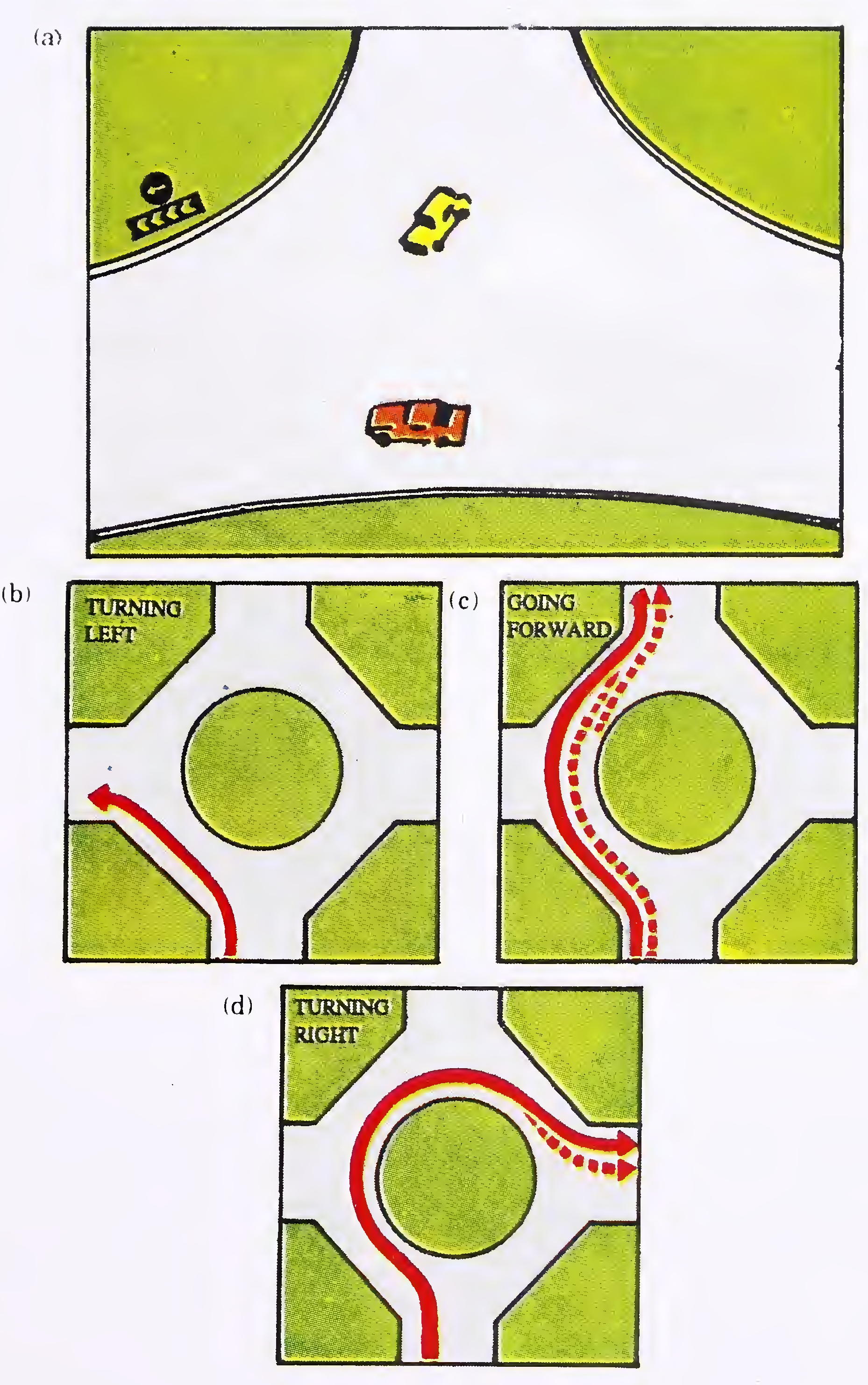
Fig. 32. Turnings at Round Abouts47
you to yield to other traffic. Sometimes a driver going through an intersection must stop for a car coming from left, if necessary to prevent an accident. Do not insist on your right-of-way, if, by doing so, you will be involved in an accident. However, if an accident does occur, the other party would be declared as at fault.
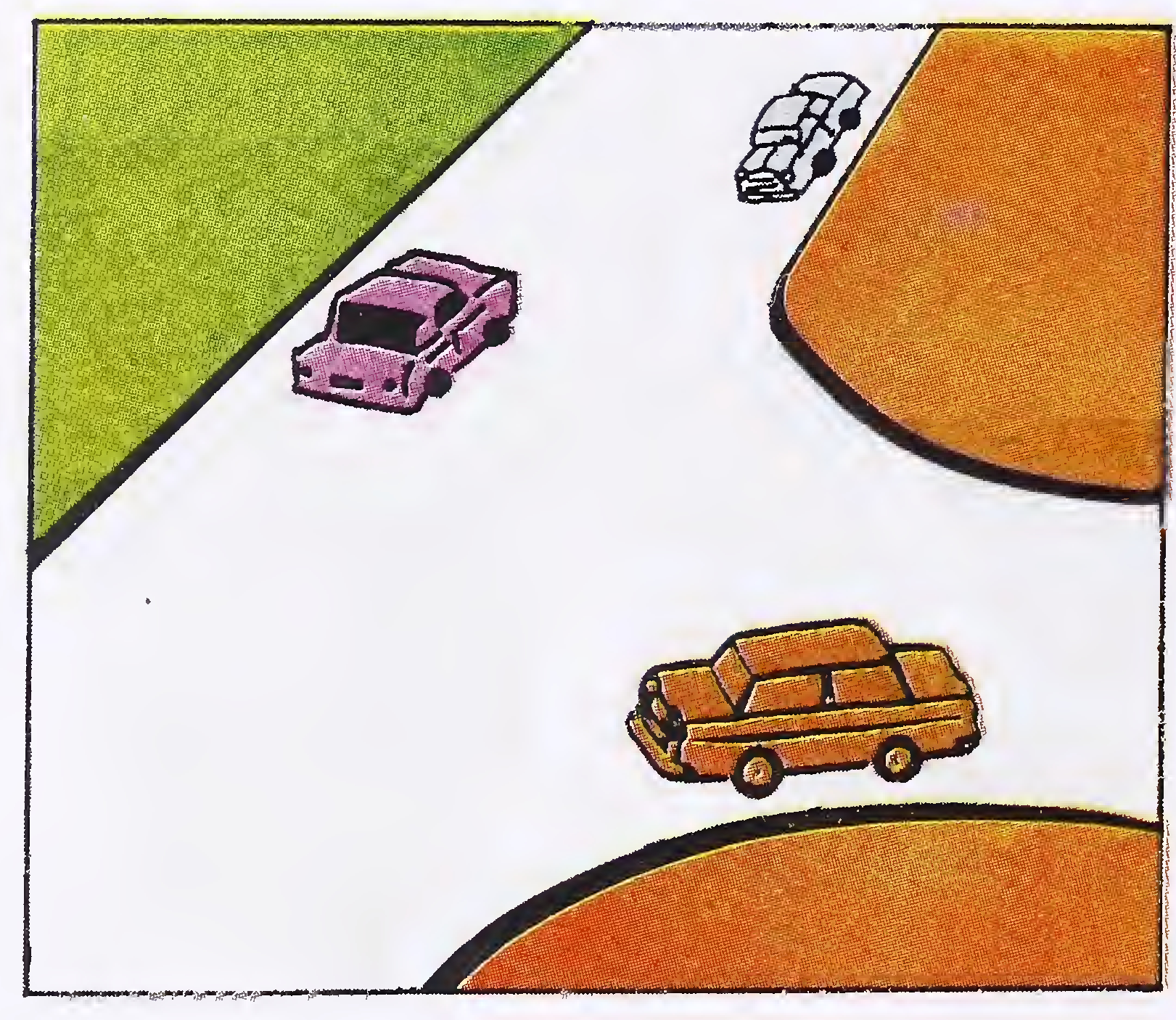
Fig. 33. Give Way Marking
When there are no signs, signals or markings to tell you what to do, the following rules should be followed:
Do not park where parking is prohibited and do not even stop where parking and stopping is prohibited. At many locations, parking is prohibited, and others both parking and stopping is prohibited. Difference is in the intention and period of stop. Parking is a state of continued stopping exceeding 3 minutes in which driver may leave the vehicle such that the vehicle cannot be driven right away. When one stops to let people in and out of a car if bags and goods are unloaded, it is a stop and not a parking e.g. at airport entrance.
Before you park or stop, ensure that it is legal to do so in that zone. If there is a “No Parking” or “No Parking and No Stopping” sign posted nearby and/or there is a yellow line (continuous or otherwise) painted on the curb or at the edge of pavement, it is illegal to park in the length defined by the yellow line or the definition plate of the no parking sign. There may be time limits and days of week defined for no parking. Illegal parking or stopping not only creates traffic congestions and other problems in the area, but because it cuts down on visibility, it causes accidents.
Never park your vehicle in the following places:
Before opening any door of a vehicle, look round to ensure there is no one on the road or footpath close enough to be hit by the door. Get out of the vehicle on the side nearer the kerb and insist on others (specially children) doing the same even if they are sitting on the other side of the vehicle.50
Before getting off, see that the doors have been properly closed and locked. Similarly when coming to stop, get as close to the kerb as possible. Before leaving the vehicle, make sure your handbrake is on firmly and the engine and headlamps are switched off. Always lock your vehicle and do not let the ignition key remain in the vehicle.
Do not park your vehicle on the road if there is fog. If it cannot be helped, do not leave your vehicle without lights.
If vehicles have to be parked for the night without lights, they should be parked as near the street light as possible.
Keep in mind that night driving means poor visibility, expect a reduction in your ability to distinguish cars, pedestrians or people or cycles as quickly as in the day time. Ability to judge speed diminishes and to make matters worse, you can expect a good number of drunks on the street and a lot of tired pedestrians and cyclists. You must, therefore, drive slower and keep a constant eye out for any roadside pedestrian, cyclist or car that is illuminated by passing headlights even briefly. If you see a flashing of brake light or see a weave or even a single stagger slow down.
Reduce the night accident danger in following ways:-
Dust storm reduce the forward and lateral vision and dust also blinds pedestrians, cyclists or motor cyclists who may wander across your path. In addition, weak tree branches, power cables or hoardings may break and fall across the road. In such conditions keep your lights on and drive very slowly watching for pedestrians, cyclists, etc. Use the centre line marking, guard rails or tail lights of vehicles in front to guide you along the road but do not drive too close to the vehicle in front. Use your horn freely to avoid danger especially at blind curves or turns. Do not park under trees, hoardings or power lines.
manoeuvres can cause skids and overtaking under wet conditions.
Put on your light in fog and drive slowly, using road markings, guide rails and tail lights of the car in front as a guide. If you have yellow fog lights use them. Use them at blind corners.
For a motorcyclist/scooterist, completion of the journey safely, without any mishap depends on proper protective gear and check of vehicle before start. The following are essential:
Most injuries to motorcyclist or scooterist. are on the head or on the legs. Most problems arise due to dust/insects getting in the eyes. Three most important things, therefore,53
are leg-guards, helmet and eye protection (see Fig. 34).

Fig. 34. Protective Gear
‘A’ Helmet: No rider should enter a road without a helmet. Pillion rider should also wear a helmet. Even a poor helmet is a little better than no helmet. When you put on the helmet, make sure it is securely fastened. Studies of cases of accidents show that a loose helmet is only slightly better than not wearing a helmet at all. A helmet should:
'B' Eye protection: Your eyes need protection from wind, dust, dirt, rain, insects and the small pebble thrown up from vehicles ahead. A plastic face/shield is best but a set of goggles can also suffice. To be effective eye protection must:
Tinted eye protection should not be worn at night.
Make sure that you are familiar with the motorcycle before you ride it on the road. Check the tyres for proper air pressure, worn or uneven tread and or damage or cracks. A blow out on a motorcycle can be extremely dangerous.
Check brakes by trying front and rear separately and ensure that each one holds the vehicle when it is fully applied. Check your headlights, turn lights, brake lights and tail lights. Check horns. Make sure that the drive chain is properly adjusted and lubricated. Adjust mirrors before you start so that you can see on both sides of your body.
Drivers of cars involved in collision with motorcycles often say that they never saw the motorcycle. The motorcycle rider must, therefore, for his own safety make efforts to make himself more noticeable. The best thing to do is to keep the headlights on at all times. This makes the vehicles one and a half times more visible. Wear bright coloured reflective helmets and clothing. Yellow, orange and red colours are most easily seen. Reflective tape clothing also helps, carry a reflective vest to wear at night.
Make extensive use of horn to draw attention to yourself. Blow a horn while overtaking, when you see a parked car about to start or while passing cyclists or if you have doubts about what others might do.
Keep your motorcycle where it can be seen. Know the “blind spots” for vehicle of cars and trucks and do not ride in the55
blind spot areas (see Fig. 35). Either drop behind or quickly pass the blind area. Try to ride where you can see the rear view mirrors of the vehicle ahead and keep your headlights on. Drive in the centre of lane so that you are clearly seen and not struck on the side. Use longer vehicles as a shield while turning without getting into its blind spots.
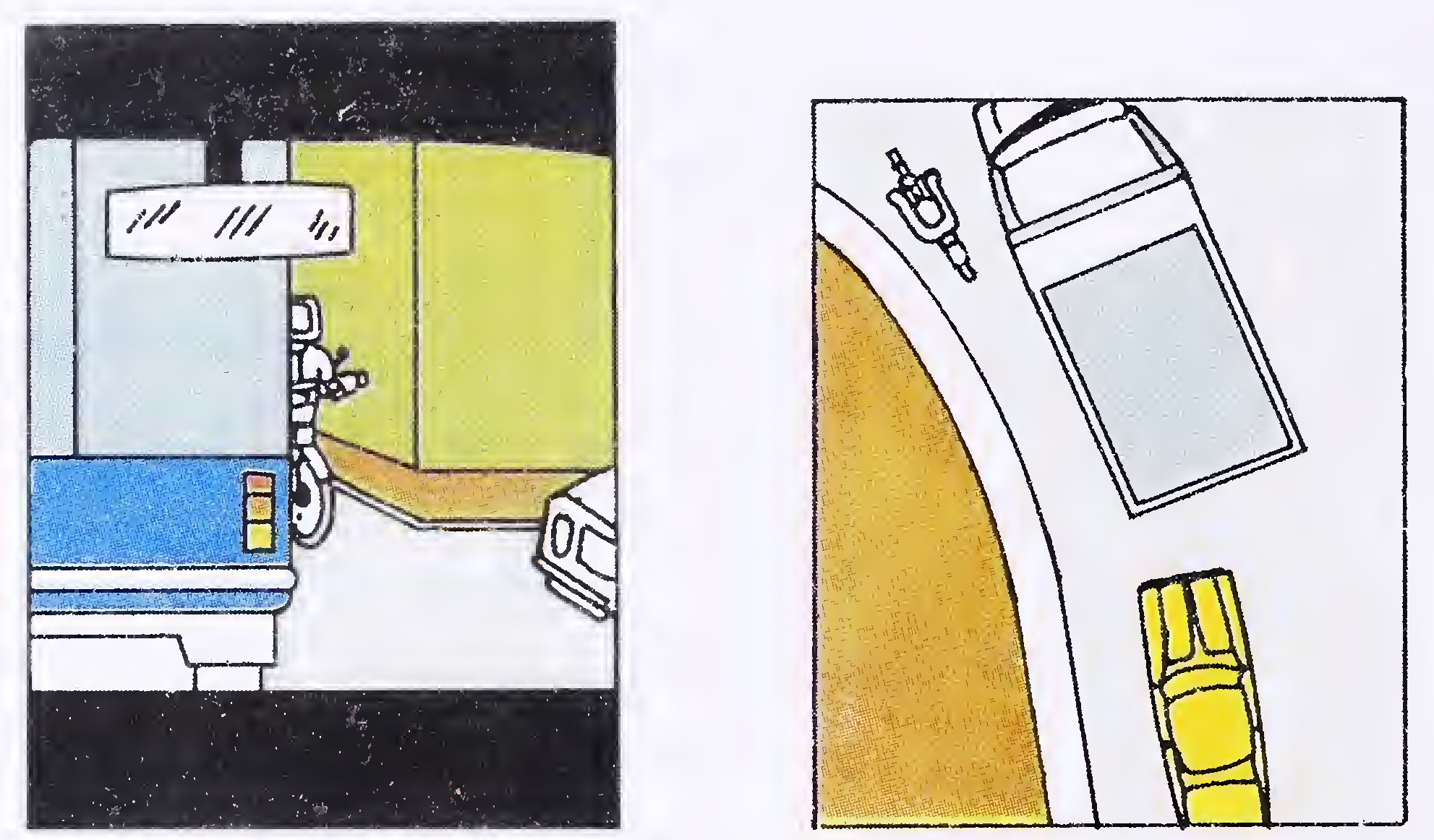
Fig. 35. Blind Spots for Motor Cycle Driver
Use your turning signal flashes to make yourself visible. However, it is dangerous to leave a turn signal blinking after having negotiated a turn.
Tap your brake pedal to flash your brake lights before you slow down.
For stopping and parking please refer to para 6.13.
A safe driver must depend on his own observation to stay out of trouble. Following rules should be followed :
estimate its distance from you. Account for convexity of mirror while doing so Before changing lane and making a turn make a final head check by turning your head and seeing over the shoulder for traffic behind you. Turn only if it is safe to turn and indicate appropriate arm signal (see Fig. 28). Also refer to Para 6.10.
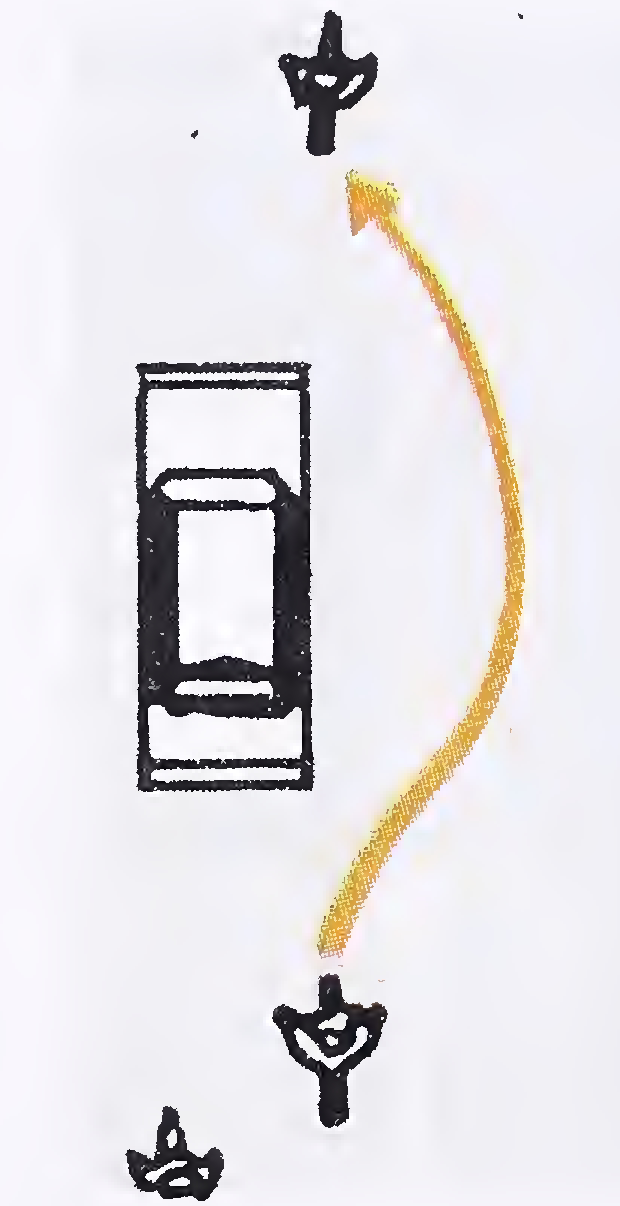
Fig. 36. Overtaking by Motor Cycle
a safe distance from others and drive in staggered formation with 2 seconds distance between riders. While overtaking do it one at a time. (See Fig. 37).
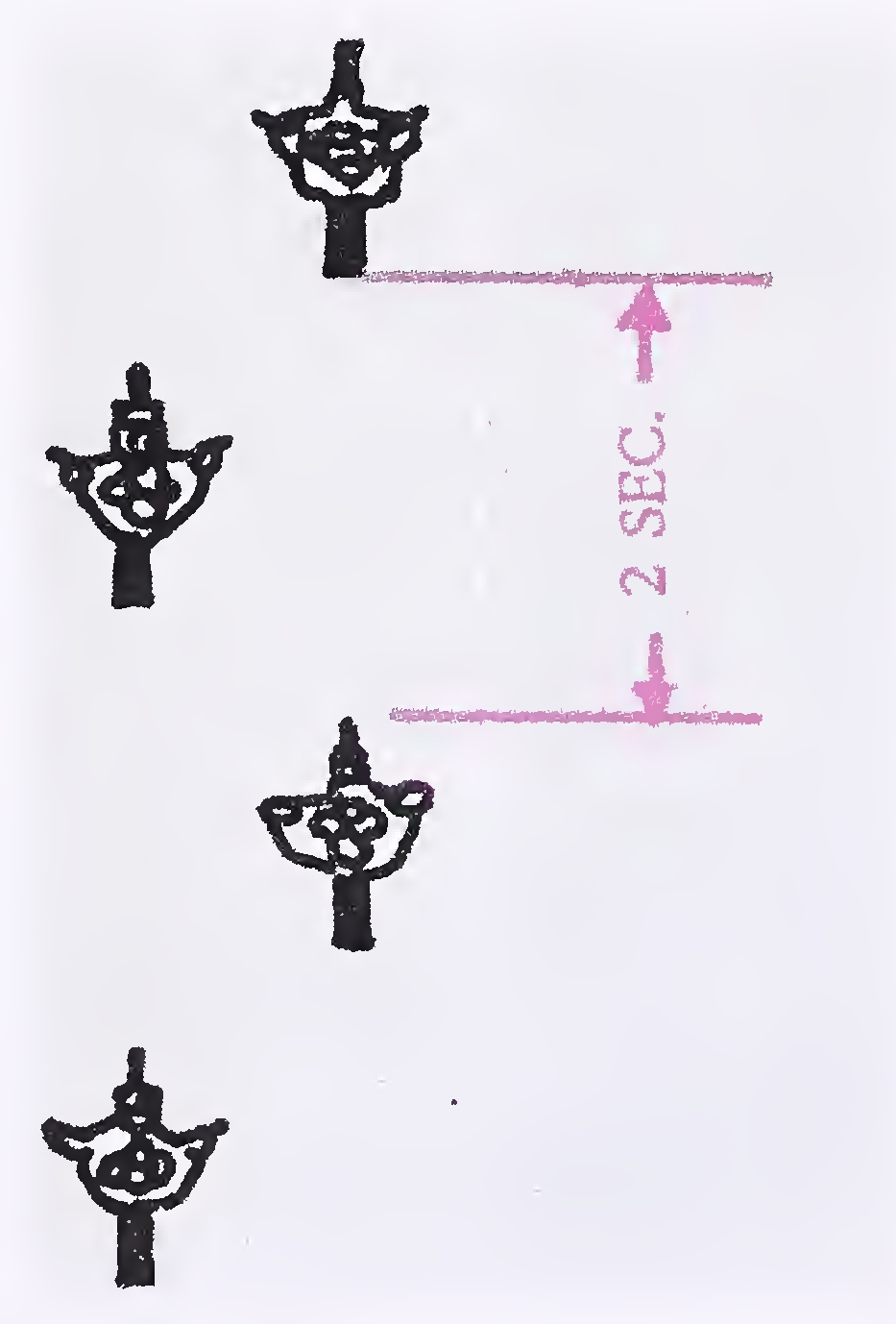
Fig. 37. Travelling in Groups
Truck and Bus Drivers require special knowledge and skills and since they share the road with many smaller vehicles and vulnerable road users, they have an additional responsibility for taking all possible safety precautions.
Take a walk around the vehicle before starting, checking each relevant component. Look for broken disconnected wires, loose bolts, cracks in metal, lights that do not work, flat tyres or any other damage which could effect the safety of the vehicle. Make a special check of the following:
Upon completion of predrive circle check, make a brake test with foot pedal within the first 15m of movement of truck.
Every truck, trailer and truck tractor must be equipped with58
rear wheel shield/guards to prevent spraying of water, dirt or gravel from ground surface from the rear wheels to vehicle behind.
The load in the vehicle must be secured to prevent its dropping, sighting, leaking or otherwise escaping.
When towing vehicles the connections must be strong enough to pull all the weight towed and the impact of sudden pull and the distance between the two vehicles should not exceed 4.5m. The towed vehicle must have a red flag displayed on the connection between the vehicles.
The bus driver’s most important concern is the safety of passengers. The following points should be taken care of while driving bus:
Truck and Bus drivers must pass other vehicles only when they are certain that there is adequate clear space ahead for completing the pass without racing and without risk to themselves and others. He must not try to pass unless there is enough difference between his speed and that of the vehicle ahead so that he can pass safely and without undue delay. He must not pass more than one vehicle at a time. If he stresses to pass a line of traffic he may find himself in a position where he cannot return to the left lane should the need arise. On multi-lane highways, he should not pass if he is likely to block faster traffic overtaking from the rear.
When overtaking, signal must be given to indicate change of lane both when pulling out to pass and when returning to the left hand lane. The signal is only an indication of driver’s intention, but it does not give him the right of way or guarantee that he can change lane safely. He must always check traffic carefully and pass only when he can do so safely and without interference.
When being passed by another vehicle, he should keep well to the left side and if necessary reduce speed to allow safe passing. He should never speed up to prevent another driver from passing and should be alert to the driver who tries to pass in an unsafe place. He should not try to block him and be ready to do anything that may be necessary to avoid being involved in an accident.
At night he must dim the light after being passed to avoid creating glare in other driver’s mirror.
Drivers of large vehicles must adjust their speeds as necessary and prudent for safe driving. Driver must take into consideration the weather, the condition of the road, traffic density, the type of load carried, the condition of tyres and brakes and his own physical and mental condition.
Generally the heavy vehicles must adjust their speed to match the traffic flow. Driving faster than the flow of traffic would involve continuously changing lanes thereby increasing risks of being involved in an accident. This would involve constantly reducing gap60
between his vehicle and the traffic ahead giving little space to stop in an emergency. It creates more driving problems and increases chances of a driver making a wrong decision. On the other hand driving slower than the flow of traffic can also be dangerous as being a source of hinderance to other cars or trucks.
Obstructing traffic going up a hill or gradient is a common complaint against trucks or buses. He should not overload the vehicle thereby causing an appreciable drop in speed on gradients. Delays should be reduced on gradients by keeping to the left and allowing faster traffic to pass. On narrow winding hilly roads it may be necessary to pull over and stop where convenient to allow congested traffic behind to pass.
While making left turn driver should try to stay within proper lane but this may not be possible in a combination vehicle. He should know the amount of “off-tracking” in his vehicle for various curve radii. He should remember that cutting too short to left into a street will cause rear wheel to run over the curb or shoulder. He thus runs the risk of damaging tyres, endanger pedestrian, or hit fixed objects such as telephone or power poles or sign posts. If the streets are narrow, he will have to proceed well into the intersection i.e. into the second traffic lane before having his turn (see Fig. 38). If he has to swing wide, he should be very sure that this can be so done safely. If he has to block off the other traffic lane he should ensure that smaller vehicles are not trying to go around on his left. If they are, stop and wait for them to clear. If he has to swing wide, it should be made into the street he is entering (and not into the street he is entering) and not into the street he is turning from, so that the traffic in front is clearly visible.
When making a right turn, he must check traffic conditions in all directions before turning and continue to check traffic while making the turn. Entering the intersection keeping just to the left of centre and making sure that the vehicle’s rear wheels are not cutting so short that they might strike other vehicles at the curb.61
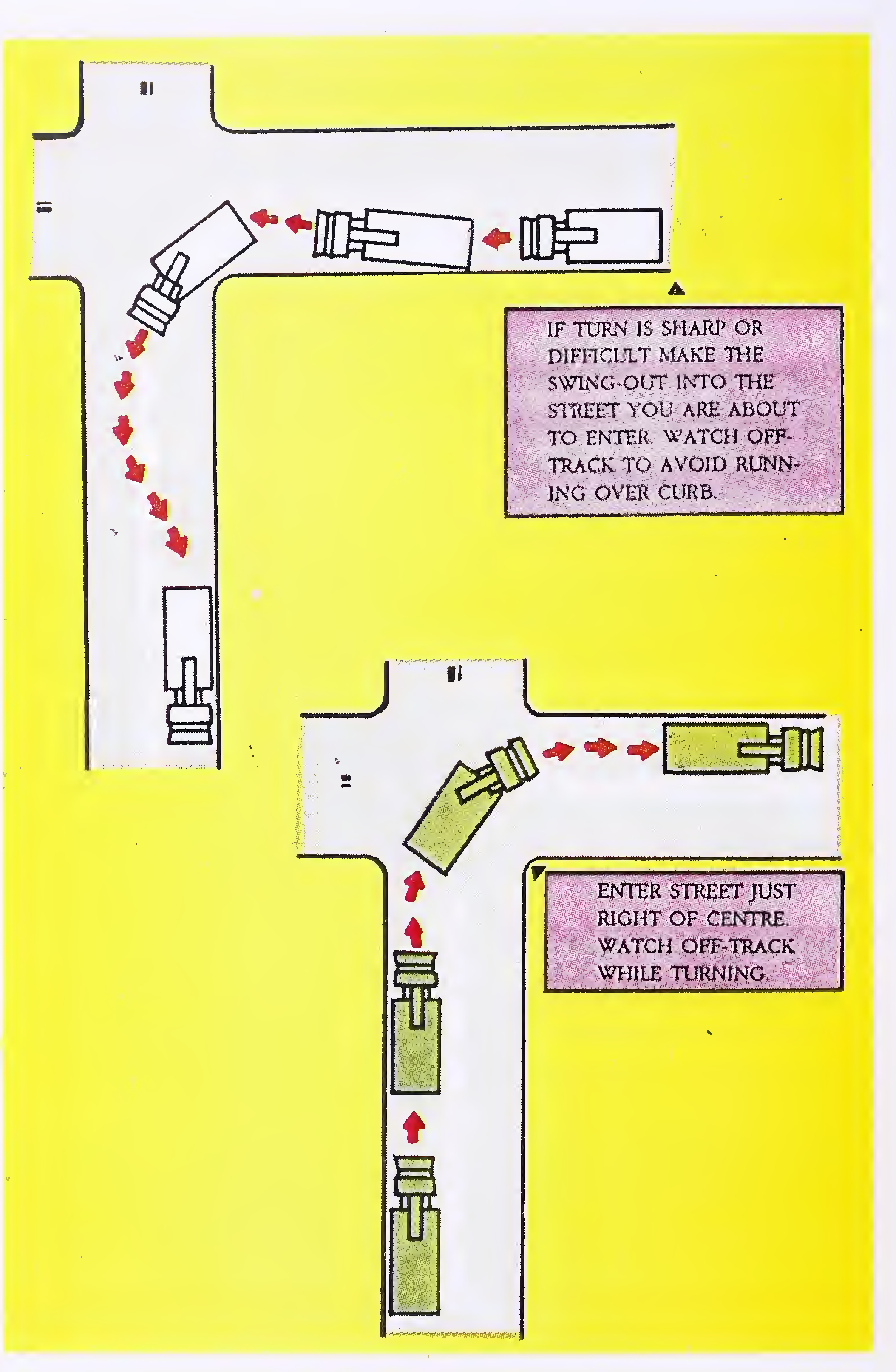
Fig. 38. Turning at Junctions62
It is important that he enters the curve at a proper speed so as not to expect to slow down after entering the curve. If he enters the curve too fast the vehicle will skid and roll over. If he applies brakes on a curve, the vehicle may skid or jack-knife. He should begin to accelerate only after having passed the mid-point of the curve.
The most important thing to understand while driving long heavy vehicles is that while going on curves the rear of the vehicle follows a different path than the front and the difference in track is called the “off-tracking”. The greater the distance between the front wheels and the rear wheels and the sharper the turn, the greater is the amount of off-track. Every driver must know the magnitude of off-tracking on narrow curves. On right curves, he should keep the front of the vehicle towards the outside of the curve so that the rear will not cut short into the opposing traffic lane. On the left curve, he should keep the vehicle front towards the centre of the road so that the rear does not run off the road (see Fig. 39)
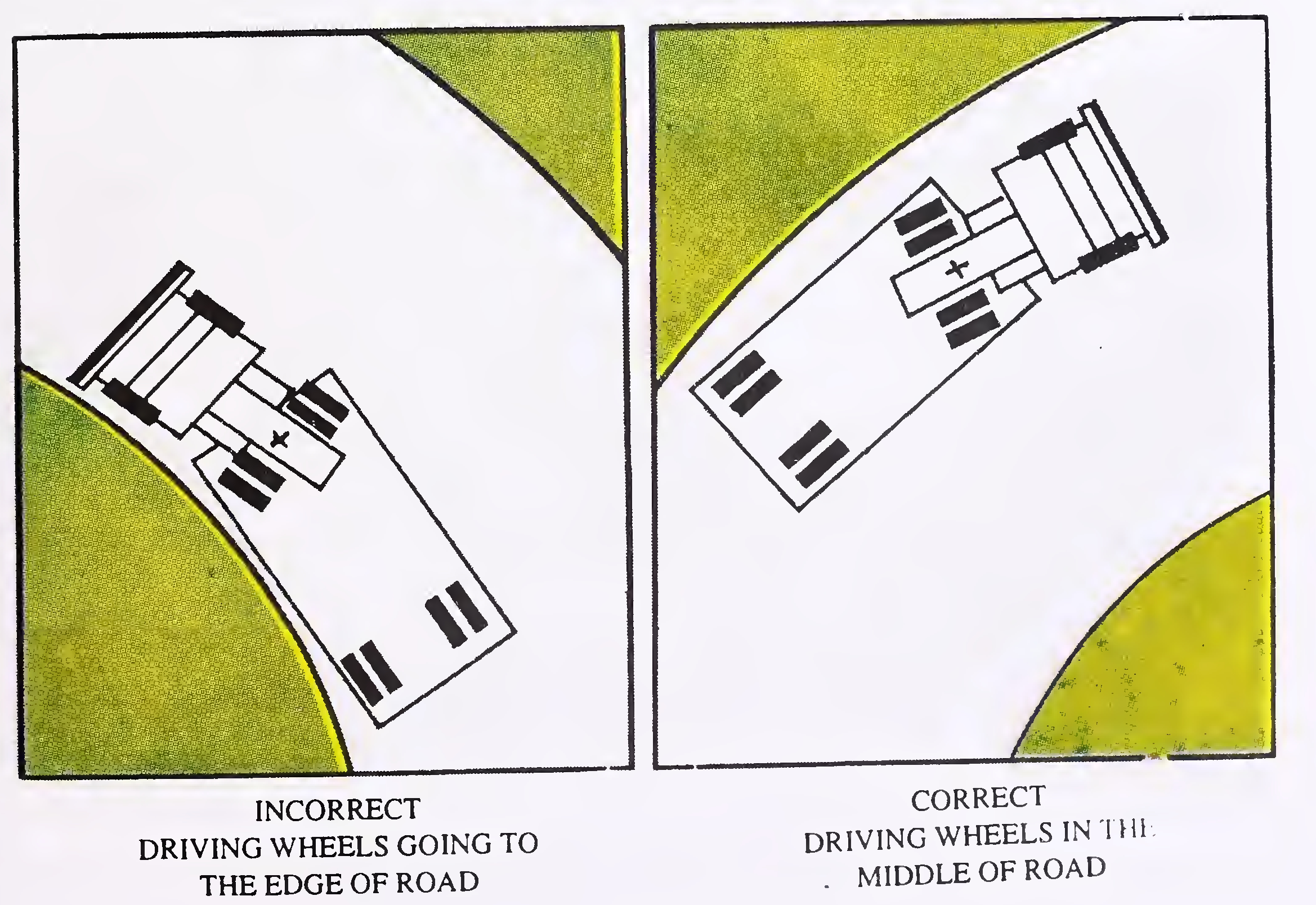
Fig. 39. Position of Driving Wheels While Taking a Turn63
He must not reverse the vehicle unless he can do so without interfering with other traffic. The vehicle should be parked safely and cleaner/conductor asked to get down and stand on left side and guide while reversing. Even with a guide, driver is the one responsible for reversing.
The control of single unit truck while reversing is the same as that for a car. The steering is turned in the direction of the movement of back end. But while turning a combination vehicle driver must move the steering in the direction opposite to that in which the rear of semi-trailer is to be moved. The trucks-tractor follow an S-shaped curve. Familiarity with turning is a must and reversing should be done carefully.
The driver should not park in middle of the road or leave the disabled vehicle on the carriageway. The shoulder should be used to park the vehicle. In cities he should pull as far as possible to the left and park on untravelled portion of road. Vehicle should never be parked where it obscures another driver’s vision or obstructs a turning movement.
When parking, set the parking brake and place the transmission in the lowest forward gear or reverse. If there is a kerb, turn the front wheel towards the curb on downgrade or level surface and away from the curb when parking on an upgrade. If the grade is steep use check blocks under the wheel. Never park on a steep grade unless absolutely necessary.
When vehicle is disabled, or stopped for more than ten minutes on a roadway, use four way flashing signal to warn traffic.
If the load on any vehicle extends more than 1 m beyond the rear of vehicle, a red flag must be displayed at the end of load during day and red light at night.
If the vehicle is disabled, it is important to give warning64
to other road users by use of red flags: reflective triangles and red lanterns. Place one warning flag or triangle at least 30 m behind the vehicle and one at each edge of vehicle. At night arrange for a lantern to be placed at the same distance and on outer edge of vehicle to delineate it clearly. Do not put stones or obstructions on the road which are not clearly visible. On removal of vehicle remove all the obstructions placed on the road.
Even if you obey all traffic laws and drive safely, things may happen which you do not expect. If you are like most drivers, you won’t have the opportunity to practice your response to an emergency before it happens. Knowing how to handle driving emergencies will help you to avoid a serious accident. When confronted with an unexpected situation, you will have to use skills of steering, acceleration and braking, used individually and in combination to face the emerging situation successfully. Given hereunder are some standard useful procedures:
Good steering skills are essential to maintain control of your vehicle. Often in an emergency you must react quickly and correctly to avoid an accident. To steer quickly, you must hold the steering wheel correctly.
To turn quickly to the left follow the steps shown in Fig. 40.
To turn to the right, follow these same steps but turn the steering wheel in the opposite direction.
To turn quickly, your hands must be on opposite sides of the steering wheel (the nine and three o’ clock hand positions), get used to holding the steering wheel this way all the time.
At times you have to accelerate to avoid an accident. For example, if another car is about to hit you from the side or from behind, you must speed up to avoid a collision.65

Fig. 40. Steering
While braking is often an essential response to driving emergencies, using your brakes improperly can actually cause an accident. In emergencies many drivers simply slam on their brakes. This locks the brakes, puts the car into a skid and makes it impossible to steer. Pumping the brakes is generally the best way to stop. The car stops quicker and you maintain your steering control. This improves your chances of avoiding a collision.66
Skidding often results from such conditions as ice, wet roads or fast speeds. If your car begins to skid, follow these steps:-
Skid happens most often on slippery surfaces. A road that is safe under most conditions can be dangerous when slippery. Ice and packed snow, especially when you are driving at high speeds or going downhill, can cause the car to skid.
If you are about to drive over a slippery surface or if your car is hydroplanning these tips may help you avoid a skid:
No matter how well you take care of your car, there is still a chance of car failure. Some of the more common car failures and what to do about them are as follows:
If your brakes suddenly give out ...
Although tyre blowouts are sometimes preceded by thumping sound, you do not usually have advance warning. As a result, it is important to protect against blowouts by keeping your tyres in good condition and properly inflated.
If you have a sudden tyre blow out:
If the engine stalls:
If your headlights suddenly go out ...
The car just keeps on going faster and faster ...
If your wheels drift on to the road shoulder, slow down gradually until you can pull back on to the road safely. When the shoulder is below the edge of the road, avoid rubbing your tyres against the pavement edge.
If there is obstruction on the road shoulder which prevents you from slowing down, centre your car over the road edge. Steer quickly to the left. When the front wheels of your car re-enter the pavement, steer to the right.
You may not always be able to avoid a collision. To protect yourself, wear your seat belt and shoulder harness and adjust your head rest.
Other ways to cut down the severity of injury in an accident are:
If you are about to be hit from the rear:
If you are about to be hit from the side
If you are about to be hit from the front
You are better prepared to handle any emergency if you are69 wearing your seat belt and shoulder harness. Seat belts increase your chances of surviving a collision. These chances are even better when you wear both a seat belt and a shoulder harness.
Some of the advantages of wearing safety belts are:
Seat belts and shoulder harness can only do all these things if they are buckled. You won’t have time to buckle your seat belt in an emergency, so you have to do it before you start to drive.
Use seat belts properly. Keep the lap belt fairly tight, but comfortable, across your lap and hips. Make sure it is below your stomach and rests on your hip bones. Adjust the shoulder harness so it’s loose enough to let your fist go between the belt and your chest. If you wear your seat belts like this, they will be comfortable and give you ample protection.
If you are involved in an accident:
Your name and address70
- Your driver’s license number
- Date and time of the accident
- Your insurance company’s name and your policy number.
Whenever there is a traffic accident, the driver on the scene should help the victims. Necessary arrangements to assist the injured persons by arranging him to be carried immediately to the nearest hospital should be made.
Notify the nearest Police Station by Telephone or otherwise, as quickly as possible, if your vehicle is involved in an accident. Irrespective of whether you are at fault or not, you are required to stop and remain stationary as long as reasonably necessary.
Most of the fatalities in road accidents occur due to heavy bleeding and lack of immediate medical attention. If there are injured people, apply whatever First Aid you can until the victim can be transferred to a hospital. This might include trying to stop heavy bleeding with bandage, handkerchief and clean clothing, if necessary. Be careful about moving the injured especially those with head injuries. If there is an immitent danger that later harm could be done to the injured or that non-removal from the road could result in another accident, do your best to get the injured to safety as quickly as possible.
No matter how minor the accident, it should be reported to the Police. Even if you have no external injuries, but have received severe thumping on the head you must go in for a medical check up. If not done, the injury may show up later and you may have complications.
When injuries have resulted from a traffic accident, do the following as quickly as possible:
Look over the injured. In order to get the needed emergency care, call ambulance and police services. First of all make the following quick assessment of injuries:
After you have a good idea of the extent and priority of injury, administer first aid as below:

Fig. 41. Aid to Accident Victim72
If the victim has a head or neck injury, it is risky to move him around. Better leave him as he is, until the ambulance and doctor arrive.
When driving it is not enough to merely know what to do, should there be an accident. Be ready for the worst and have the necessary bandages and gauge with you in your car.
In India, the traffic is governed by several laws some of which are listed below:
Motor Vehicle Act lays down detailed laws and procedure for licencing of Drivers, registration of vehicles, control of Transport vehicle, control of Traffic, insurance of vehicle and offences and penalties. There are additional rules for traffic under other State enactments. A schedule of Traffic offences prepared by Delhi Police is given as Appendix I for guidance of road users so as to make them aware of their obligations.
or police officer on duty.
your feet on both pedals unless the exigencies of the situation warrant you to do otherwise for sometime.
mirrors to enable you to see the traffic behind you.
The most important factor in driving is the driver himself. All other considerations, such as road worthiness of the vehicle, speed of travel and so on, are his responsibilities and within his control.
The make up of a good driver is determined by permanent physical and psychological character and certain temporary influences which limit his ability to drive safely. All other driving hazards become many times worse if he is not at his physical and mental best.
Driving involves the same attitudes which are desirable in all walks of life—courtesy, responsibility, maturity, unselfishness, tolerance and dependability. One can be an excellent driver mechanically but it is the mental attitude to driving which really counts. Driving a motor vehicle is a full-time occupation both mentally and physically. Carelessness and a selfish attitude towards other road users account for most of the accidents. Good vision, good hearing and a good standard of health all have an essential bearing on the power of concentration and perception so necessary in present-day driving.
Moreover the vehicle driver must be able to formulate a safe driving plan for every circumstance on the road, and then carry that plan into effect with deliberation. To do this his muscular system must79
be in good condition, when driving. The movements of the limbs exercising control of the vehicle must be sure and accurate.
Before moving off, you should know your capabilities as well as the vehicle you are going to drive. You should not drive fast unless you are familiar with its behaviour and never demand more of it than you know you can get.
Make sure that:
In addition to the above, a scooter should have:
In addition to what is mentioned at para 13.5.2, a motor cycle should have:
In addition to what is mentioned at para 13.5.1, a car/bus/truck should:
In addition to what is stated above, it is always useful for a scooterist/motor-cyclist:
There is no vehicle so far manufactured which will go on running month after month without due attention. From the day a vehicle leaves the manufacturing plant, it starts to wear and this process involves the gradual deterioration of vital working parts.
Besides replenishing petrol, and paying for insurance tax token and servicing, the following vehicle parts should be checked:-
stop lights and turn signals should all be checked for proper operation.
Driver reaction time is the time that passes between the moment a driver observes the need for action and the moment he takes that action. It is of major importance when applied to braking. On an average a smart driver takes 3/4th of a second to react and to reach for the brakes, during which time if he is driving at a speed of 50 km/hour, he will have covered 13m without losing any appreciable speed. This is called the thinking distance. It varies with the speed of the vehicle, with the physical and mental condition of the driver and with the degree of concentration the driver is giving to his driving.
The ability to react quickly can deteriorate in several ways. Undue worry, fatigue, illness and the effects of alcohol are well known causes of lack of mental and physical well being.
It is not enough if you are a law-abiding driver. Your chances of being involved in an accident will be further lane ended, if you practice the system of defensive driving.83
In judging safety performance, we are not concerned whether you had the legal right of way or whether the other driver disobeyed traffic regulations. We are also not concerned with conditions of the road or weather. When you have failed to make an allowance and an accident results, you have failed to prevent the accident. The plain fact is that if you have failed to do everything you reasonably could have done to prevent.the accident, you are not a defensive driver.
Defensive driving includes pride in never taking to other road users by surprise, and in not being taken by surprise, pride in concentrating on your responsibilities rather than on your rights, pride in showing care, courtesy, and consideration to other road users.
The acts of a courteous driver can set an example for other road users and this can help reduce accidents. On the other hand, a discourteous act can set up a chain reaction for more discourtesy, often with tragic results.
Each driver should condition himself, so that he will react safely to situations in which danger is an element, so that safety becomes a habit.84
APPENDIX I
TRAFFIC OFFENCES UNDER MOTOR VEHICLE ACT, 1988 (MVA), CENTRAL MOTOR VEHICLE RULES, 1989 (CMVR) AND RULES OF ROAD REGULATION, 1989 (RRR)
(M = "MVA", C = "CMVR", R = ’’RRR”)
| TRAFFIC OFFENCE DESCRIPTION | RULE/SECTION | SECTION MVA 1988 |
|---|---|---|
| SIDE INDICATOR (FLASHING AMBER) NOT VISIBLE, WHEN IN OPERATION FROM FRONT/REAR | C 102(2)(1) | 177 |
| MOTOR VEHICLE WITH SIDE INDICATOR AT IMPROPER POSITION | C 103(2) | 177 |
| MOTOR CYCLE MANUFACTURED WITHOUT SIDE INDICATORS | C 103(3) | 177 |
| TRANSPORT VEHICLE NOT FITTED WITH TWO REAR RED REFLECTORS | C 104(a) | 177 |
| NON TRANSPORT VEHICLE NOT PROVIDED WITH A REFLECTOR OR A REFLECTING TAPE AS PRESCRIBED | C 104(2) | 177 |
| HTV/UNCONVENTIONAL/EXTRA ORDINARY TYPE VEHICLE NOT FITTED WITH RED INDICATOR LAMP OF PROPER SIZE | C 105 (6) | 177 |
| HEAD LAMP NOT ACCORDING TO SPECIFICATIONS/DAZZLING TO OTHERS | C 106(1) | 177 |
| HEAD LIGHT PANELS NOT SHADED BY PAINTING LIKE A BULL'S EYE AT THE CENTRE OF REFLECTORS CARRIAGE | C 106(2) | 177 |
| GOODS VEHICLE NOT FITTED WITH TOP LIGHTS AT RIGHT CORNER AT FRONT AND REAR/TOP LIGHTS NOT LIT | C 107 | 177 |
| SHOWING OF A RED LIGHT AT THE FRONT OR LIGHT OTHER THAN RED AT THE REAR | C 108 | 177 |
| NOT HAVING PARKING LIGHT FOR THE GOODS CARRIAGE (FRONT-WHITE, REAR-RED.) | C 109 | 177 |
| AUTO-RICKSHAW NOT FITTED WITH PRESCRIBED LAMPS (1 FRONT AND 2 SIDE LAMPS, RED REAR) | C 110 | 17785 |
| SPOT LIGHT OR SEARCH LIGHT FITTED WITHOUT PERMISSION | C 111 | 177 |
| VEHICLE NOT FITTED WITH ELECTRIC/OTHER DEVICE APPROVED BY BIS FOR GIVING AUDIBLE/SUFFICIENT WARNING | c 119(1) | 177 |
| NOT CARRYING THE LIST OF PASSENGERS DULY ATTESTED BY TOURIST VEHICLE | C 85 (1) | 192 |
| VIOLATION OF DIMENSION IN CONSTRUCTION OF VEHICLE REGARDING LENGTH, WIDTH & HEIGHT | C 93 | 177 |
| MOTOR VEHICLE NOT EQUIPPED WITH TWIN SYSTEM OF HAND BRAKES & FOOT OPERATED SERVICE BRAKES. | C 36(1) | 177 |
| BRAKING SYSTEM NOT MAINTAINED IN EFFICIENT CONDITION AND CAPABLE OF STOPING THE VEHICLE | C 96(2) | 177 |
| THE STEERING SYSTEM NOT MAINTAINED IN GOOD AND SOUND CONDITION AND NOT CONFORMING B.I.S. MARK | C 28 | 177 |
| MOTOR VEHICLE OTHER THAN M. CYCLE & THREE WHEELED INVALID CARRIAGE NOT HAVING REVERSE GEAR | C 99 | 177 |
| THE GLASS OF WINDSCREENS & THE WINDOWS OF MOTOR VEHICLE NOT OF SAFETY GLASS (BIS) | C 100 | 177 |
| MOTOR VEHICLE OTHER THAN TWO WHEELER WITHOUT AUTOMATIC WINDSCREEN WIPER | C 101 | 177 |
| EXHAUST PIPE OF SERVICE VEHICLE NOT SHIELDED FROM INFLAMABLE MATERIAL FROM OTHER PARTS OF VEHICLE | C 114 | 177 |
| VEHICLE NOT FITTED WITH SPEEDO METER/SPEEDOMETER NOT WORKING |
C 117 | 177 |
| TRANSPORT VEHICLE NOT FITTED WITH SPEED GOVERNOR. | C 118 | 17786 |
| COMPONENTS INSTALLED BY MANUFACTURER WHICH DO NOT CONFORM TO THE STANDARDS OF B.I.S. | C 124 | 177 |
| WITHOUT SEAT BELT FOR DRIVER/FRONT SEAT, COLLAPSIBLE STEERING COLUMN/PADDED DASHBOARD/AUTODIPPER | C 125 | 177 |
| VEHICLE OTHER THAN ROAD ROLLER, OR A TRACK LAYING VEHICLE NOT FITTED WITH PNEUMATIC TYRES | C 94 | 177 |
| TYRE SIZE AND PLY RATING NOT ACCORDING TO SPECIFICATION GIVEN IN R.C | C 95 | 177 |
| VEHICLE OTHER THAN DEFENCE PAINTED IN OLIVE GREEN COLOUR | C 121(1) | 177 |
| MOTORCYCLE WITHOUT PERMANENT HANDGRIP, FOOT REST AND SAREE GUARD | C 123 | 177 |
| ISSUE AND RENEWAL OF CERTIFICATE OF FITNESS BY TESTING STATION WITHOUT AUTHORITY FROM STA | C 63(1) | 177 |
| LEARNING M.V. DRIVING WITHOUT ACCOMPANIED BY INSTRUCTOR WITH VALID D/L SITTING TO CONTROL VEHICLE | C 3(1)(B) | 177 |
| ESTABLISHING OR MAINTAINING ANY DRIVING SCHOOL OR ESTABLISHMENT FOR DRIVER TRAINING | C 24 | 177 |
| MENTION OF GENERAL CONDITIONS BY MOTOR TRAINING SCHOOL | C 27 | 177 |
| MENTION OF GENERAL CONDITIONS OF LETTER OF AUTHORITY BY TESTING STATION | C 65 | 177 |
| STARTING OR ENDING JOURNEY OUTSIDE THE STATE WITHOUT REPORTING | C 85(3) | 192 |
| TOURIST VEHICLE NOT PAINTED IN PRESCRIBED MANNER AND WORD 'TOURIST' INSERTED ON BOTH SIDES OF IT | C 85(7) | 19287 |
| TOURIST VEHICLE NOT DISPLAYING IN THE FRONT TOP YELLOW BOARD SHOWING VALIDITY FOR STATES | C 85(8) | 192 |
| OPERATING TOURIST VEHICLE AS A STAGE CARRIAGE | C 85(9) | 192 |
| NOT MAINTAINING A LOG BOOK IN PRESCRIBED MANNER BY A TOURIST VEHICLE | C 85(10) | 192 |
| WORDS 'TOURIST VEHICLE' NOT PAINTED ON MOTOR CAB ON BOTH SIDES IN PRESCRIBED MANNER | C 85(B)(1) | 192 |
| BOARD SHOWING THE VALIDITY OF PERMIT FOR STATES NOT DISPLAYED IN FRONT OF MOTOR CAB ABOVE NO. PLATE |
C 85(B)(2) | 192 |
| NOT FILLING QUARTERLY RETURN IN FORM 49 BY NATIONAL PERMIT HOLDER | C 89 | 192 |
| NOT DISPLAYING THE WORDS 'NATIONAL PERMIT' IN PRESCRIBED MANNER ON NATIONAL PERMIT VEHICLE | C 90(1,2) | 192 |
| CARRYING ANY GOODS WITHOUT A BILL OF LADING IN FORM 50 BY NATIONAL PERMIT VEHICLE | C 90(3) | 192 |
| NOT PROVIDING TWO DRIVERS AND A SEAT FOR SPARE DRIVER TO STRETCH AND SLEEP ON BACK OF DRIVER SEAT | C 90(4) | 192 |
| PICKING UP OR SETTING DOWN GOODS BETWEEN TWO POINTS SITUATED IN THE SAME STATE BY N.P. VEHICLE | C 90(7) | 192 |
| PASSENGER ENTRANCE & EXIT GATE NOT AS PRESCRIBED FOR TOURIST VEHICLE | C 128(3) | 177 |
| NOT PROVIDING OR IDENTIFYING EMERGENCY DOORS FOR TOURIST VEHICLES | C 128(4) | 177 |
| WITHOUT SEPARATE DOOR WITH SLIDING WINDOW NEAR THE DRIVER'S SEAT OF TOURIST VEHICLE | C 128(5) | 17788 |
| WITHOUT FRONT WIND SECREEN OF CLEAR AND DISTORTION FREE SAFETY GLASS | C 128(6) | 177 |
| VEHICLE WITHOUT PRESCRIBED WINDOW SIZE/LAMINATED SAFETY GLASS IN WINDOWS | C 128(7) | 177 |
| NOT PROVIDING LUGGAGE HOLDS AT THE REAR OR AT SIDES OR AT BOTH OF TOURIST VEHICLE | C 128(9) | 177 |
| TOURIST VEHICLE EXCEEDING CAPACITY OF 35 PASSENGERS EXCLUDING DRIVER/ATTENDANT OF TOURIST VEHICLE | C 128(10) | 177 |
| PASSENGER COMPARTMENT NOT ADEQUATELY ILLUMINATED IN TOURIST VEHICLE | C 128(12) | 177 |
| USING TRADE REGISTRATION MARK AND NUMBER ON VEHICLE OTHER THAN FOR WHICH IT WAS ISSUED | C 39(1) | 177 |
| NOT CARRYING TRADE CERTIFICATE AND DISPLAYING TRADE REGISTRATION MARK AT CONSPICUOUS PLACE | C 39(2) | 177 |
| USING A TRADE CERTIFICATE BY THE PERSON OTHER THAN TO WHOM IT WAS ISSUED | C 40 | 177 |
| USING M.V. IN PUBLIC PLACE WITH TRADE CERT FOR PURPOSES OTHER THAN TRIAL/TEST/BODY BUILDING ETC. | C 41 | 177 |
| DELIVERY OF VEHICLE TO PURCHASER WITHOUT REGISTRATION WHETHER TEMPORARY OR PERMANENT | C 42 | 177 |
| NOT MAINTAINING A REGISTER IN FORM 19 BY THE HOLDER OF TRADE CERTIFICATE | C 43 | 177 |
| NOT DISPLAYING REGISTRATION MARK IN PRESCRIBED FORM AND MANNER (DEFECTIVE NUMBER PLATE) | C 50 | 177 |
| REGISTRATION MARKS ON M.CYCLE AND INVALID CARRIAGE NOT ACCORDING TO SPECIFICATION |
C 51 | 17789 |
| USING NON TRANSPORT VEHICLE AFTER EXPIRY OF R.C. (15 YEARS) WITHOUT RENEWAL | C 52(3) | 192 |
| NOT DISPLAYING REGISTRATION MARKS IN THE PRESCRIBED MANNER BY DIPLOMAT OR CONSULAR (CD VEHICLE) | C 77 | 177 |
| NOT CARRYING/PRODUCING FITNESS, AUTHORISATION, INSURANCE, R.C. NATIONAL PERMIT & TAX TOKEN | C 90(5) | 192 |
| CONSIGNER NOT SUPPLYING ADEQUATE INFORMATION ABOUT DANGEROUS /HAZARDOUS GOODS TO DRIVER/OWNER | C 131 | 190(3) |
| DRIVER WITHOUT INFORMATION OF DANGEROUS/HAZARDOUS GOODS GIVEN BY OWNER/CONSIGNER WHILE TRANSPORTING | C 132(3) | 193(3) |
| NOT TAKING NECESSARY PRECAUTION FOR TRANSPORTING DANGEROUS/HAZARDOUS GOODS BY DRIVER | C 133 | 190(3) |
| NOT PRODUCING R.C., INSURANCE, FITNESS, PERMIT, D/L, OR OTHER RELEVANT DOCUMENTS OR EXTRACTS OF THEM | C 139 | 192 |
| NOT DISPLAYING 'L' PLATE IN RED ON WHITE BACK GROUND WHILE DRIVING WITH LEARNER'S LICENCE | C 3(1)(C) | 177 |
| DRIVING IN PUBLIC PLACE 1/2 HR AFTER SUNSET AND 1/2 BEFORE SUNRISE | C 105(1) | 177 |
| GOODS CARRIAGE TRANSPORTING DANGEROUS/HAZARDOUS GOODS NOT LEGIBLY MARKED WITH EMERGENCY INFORMATION | C 134 | 190(3) |
| NO REPORTING THE OCCURRENCE OF ACCIDENT INVOLVING DANGEROUS/HAZARDOUS GOODS TO NEAREST POLICE STATION | C 136 | 190(3) |
| PARKING OF TOURIST VEHICLE ON BUS STAND USED BY STAGE CARRIAGE AND OPERATING FROM THAT BUS STAND | >C 185(6) | 19290 |
| NOT COMPLYING WITH THE CONDITIONS WHILE TRANSPORTING GOODS OF DANGEROUS OR HAZARDOUS NATURE | C 129 | 190(3) |
| NOT DISPLAYING MARK OF CLASS, LABEL WITH TYPE, WHILE TRANSPORTING DANGEROUS OR HAZARDOUS GOODS | C 130 | 190(3) |
| EMITTING EXHAUST GASES FROM ENGINE DOWNWARDS OR TO LEFT SIDE OF THE VEHICLE | C 112 | 177 |
| EXHAUST PIPE LOCATED WITHIN A DISTANCE OF 35 MILLIMETERS FROM THE FUEL LINE CONNECTING TANK & ENGINE | C 113 | 177 |
| EMISSION OF SMOKE, VISIBLE VAPOUR, GRIT, SPARKS, ASHES, CINDERS OR OILY SUBSTANCE FROM EXHAUST | C 115(1) | 190(2) |
| NON SUBMISSION OF THE VEHICLE FOR TEST OF MEASURING THE STANDARD OF SMOKE/OTHER POLLUTANTS | C 116(2) | 190(2) |
| VEHICLE WITHOUT SILENCER | C 120 | 190(2) |
| NOISE FROM VEHICLE EXCEEDING NOISE POLLUTION NORMS | C 119(2) | 177 |
| VIOLATION OF PROHIBITION OR RESTRICTION BY HEAVY GOODS/PASSENGER VEHICLES IN ANY AREA OR ROUTE | M 113(1) | 194(1) |
| VIOLATION OF NOTIFICATION OF STATE GOVT. BY VEHICLES FOR PLYING IN PROHIBITED/RESTRICTED ROAD/AREA |
M 115 | 194(1) |
| WILLFULLY REMOVING, ALTERING, DEFACING OR TAMPERING WITH TRAFFIC SIGNS | M 116(5) | 177 |
| DRIVING VEHICLE WITH LEFT HAND STEERING WITHOUT MECHANICAL/ELECTRICAL SIGNALLING DEVICES | M 120 | 177 |
| DRIVING VEHICLE NOT FITTED WITH PNEUMATIC TYRES | M 113(2) | 194(1).91 |
| DRIVING WITHOUT VALID FITNESS CERTIFIATE | M 56 | 192(1) |
| DRIVING WITHOUT INSURANCE AGAINST THIRD PARTY RISK. | M 146 | 196 |
| REFUSING TO GIVE INFORMATION ABOUT INSURANCE | M 151 | 179(2) |
| DRIVING MOTOR VEHICLE WITHOUT LICENCE | M 3 | 181 |
| DRIVING OF MOTOR VEHICLE BY MINOR (UNDER AGE) | M 4 | 181 |
| OWNER OF A VEHICLE ALLOWING A MINOR OR A PERSON WITHOUT LICENCE TO DRIVE HIS VEHICLE | M 5 | 180 |
| WORKING AS CONDUCTOR OR EMPLOYING ANOTHER PERSON AS CONDUCTOR WITHOUT HAVING CONDUCTOR'S LICENCE | M 29 | 182(2) |
| SELLING OF TICKETS/SOLICITING CUSTOMERS FOR PUBLIC VEHICLE WITHOUT LICENCE BY AGENT/CONVASSER | M 93(1) | 193 |
| COLLECTING/FORWARDING/DISTRIBUTING GOODS, FOR GOODS CARRIAGES WITHOUT LICENCE BY AGENT/CONVASSER | M 93(2) | 193 |
| CONTRAVENTION OF THE PROVISIONS OF CONDUCTOR'S LICENCE | M 29 | 182(2) |
| CONTRAVENTION OF PROVISIONS OF DRIVING LICENCE | M 23 | 182 (1) |
| DRIVING OR ALLOWING TO DRIVE A VEHICLE AS TRANSPORT VEHICLE WITHOUT PERMIT | M 66 | 192(1) |
| REFUSAL BY 2/3 WHEELED CONTRACT CARRIAGE | M 178(3,a) | 178(3) |
| REFUSAL BY VEHICLE OTHER THAN TWO/THREE WHEELED CONTRACT CARRIAGE | M 178(3,b) | 178 (3) |
| FAILURE TO PROVIDE ADEQUATE VENTILATION IN PERMIT VEHICLE (TOURIST) | M 128(8) | 17792 |
| DRIVING OR ALLOWING TO DRIVE WITHOUT R.C. OR DURING CANCELLATION OR SUSPENSION OF R.C. | M 39 | 192 |
| FAILURE TO APPLY FOR NEW REGISTRATION WITH IN 12 MONTHS ON REMOVAL OF VEHICLE TO ANOTHER STATE | M 47(5) | 177 |
| FAILURE TO INTIMATE WITHIN 30 DAYS TO STA THE CHANGE OF ADDRESS OR PLACE OF BUSINESS | M 49(2) | 177 |
| FAILURE OF THE TRANSFER OR TRANSFEREE TO REPORT ABOUT TRANSFER OF OWNERSHIP WITHIN 14/30 DAYS. | M 50(3) | 177 |
| ALTERATION OF A MOTOR VEHICLE WITHOUT PERMISSION | M 52(1) | 191 |
| DRIVING OR ALLOWING TO DRIVE UNLADEN VEHICLE EXCEEDING THE WEIGHT GIVEN IN R.C. | M 113(3,a) | 194(1) |
| DRIVING OR ALLOWING TO DRIVE A LADEN VEHICLE EXCEEDING THE WEIGHT GIVEN IN R.C. | M 113(3, b) | 194(1) |
| NOT CONVEYING THE VEHICLE TO WEIGHING DEVICE WHEN DIRECTED BY AUTHORITY | M 114(1) | 194(2) |
| NOT REPORTING THE OCCURRENCE OF DAMAGE OF TRAFFIC SIGNS WITHIN 24 HRS. TO POLICE STATION/OFFICER | M 116(6) | 177 |
| TRAVELLING WITHOUT PASS/TICKET IN A STAGE CARRIAGE | M 124 | 178(1) |
| DERELICTION OF THE DUTY BY CONDUCTOR | M 124 | 178(2) |
| NOT PRODUCING D/L, C/L, R.C., PERMIT, FITNESS CERTIFICATE AND INSURANCE ON DEMAND BY AUTHORITY | M 130 | 177 |
| DUTY OF DRIVER TO STOP AT UNGUARDED RLY. LEVEL CROSSING AND ENSURE THAT NO TRAIN/TROLLEY IS COMING | M 131 | 177 |
| NOT STOPPING VEHICLE WHEN REQUIRED BY POLICE OFFICER IN UNIFORM OR BY PERSON INCHARGE OF ANIMAL | M 132(1) | 179(1)93 |
| DUTY OF OWNER TO GIVE INFORMATION OF DRIVER/CONDUCTOR ACCUSED OF AN OFFENCE UNDER M.V. ACT | M 133 | 187 |
| DUTY OF DRIVER IN CASE OF AN ACCIDENT AND INJURY TO A PERSON OR DAMAGE TO PROPERTY OF THIRD PERSON | M 134(a) | 187 |
| NOT REPORTING THE CIRCUMSTANCES TO A POLICE OFFICER OR AT POLICE STATION WITHIN 24 HRS. OF AN ACCIDENT | M 134(b) | 187 |
| CARRYING PERSON ON RUNNING BOARD OR OTHERWISE THAN WITHIN THE BODY OF THE VEHICLE | M 123(1) | 177 |
| TRAVELLING ON THE RUNNING BOARD OR ON THE TOP OR ON THE BONNET OF THE VEHICLE | M 123(2) | 177 |
| ALLOWING ANY PERSON TO STAND/SIT/PLACE ANYTHING IN A MANNER AS TO HAMPER THE CONTROL OF DRIVER | M 125 | 177 |
| TRIPLE RIDING ON A TWO WHEELER | M 128(1) | 177 |
| DRIVING A MOTOR CYCLE WITHOUT PROTECTIVE HEADGEAR (HELMET) | M 129 | 177 |
| ALLOWING THE VEHICLE TO REMAIN STATIONARY WITHOUT LICENCED DRIVER ON SEAT OR STOPPING MECHANISM | M 126 | 177 |
| DRIVING VEHICLE EXCEEDING THE MAXIMUM OR BELOW THE MINIMUM SPEED LIMIT PRESCRIBED | M 112(1) | 183(1) |
| ABETMENT FOR OVER SPEEDING BY EMPLOYER OR PERSON INCHARGE OF THE VEHICLE | M 112(2) | 183(2) |
| LEAVING VEHICLE IN DANGEROUS POSITION AT PUBLIC PLACE | M 12 | 177 |
| DRIVING DANGEROUSLY (RASH AND NEGLIGENT DRIVING) | M 184 | 184 |
| DRIVING BY A DRUNKEN PERSON OR BY A PERSON UNDER THE INFLUENCE OF DRUGS | M 185 | 18594 |
| DRIVING WHEN MENTALLY OR PHYSICALLY UNFIT TO DRIVE | M 186 | 186 |
| ABETMENT FOR DRIVING DANGEROUSLY | M 188 | 184 |
| ABETMENT TO DRIVE A VEHICLE BY DRUNKEN PERSON OR A PERSON UNDER THE INFLUENCE OF DRUGS | M 188 | 185 |
| ABETMENT TO DRIVE A VEHICLE BY A PERSON MENTALLY OR PHYSICALLY UNFIT TO DRIVE | M 188 | 186 |
| DRIVING PART IN UNAUTHORISED RACING/TRIALS OF SPEED | M 189 | 189 |
| DRIVING VEHICLE IN UNSAFE CONDITION | M 190(1) | 190(1) |
| DRIVING INJURY OR DAMAGE TO PROPERTY IN ACCIDENT BY USING DEFECTIVE VEHICLE | M 190(1) | 190(1) |
| DRIVING VEHICLE WITHOUT AUTHORITY | M 197(1) | 197(1) |
| DRIVING CONTROL OF VEHICLE BY FORCE OR INTIMIDATION OR THREAT | M 197(2) | 197(2) |
| AUTHORISED INTERFERENCE WITH THE VEHICLE | M 198 | 198 |
| DRIVING OR ALLOWING TO DRIVE A VEHICLE VIOLATING AIR/NOISE POLLUTION STANDARDS | M 190(2) | 190(2) |
| CARRYING OF PERSONS ON A TRACTOR OR IN THE DRIVER'S CABIN OF GOODS VEHICLE MORE THAN MENTIONED IN R.C. | R 28 | 119/177 |
| CARRYING OR PLACING OF GOODS SO AS TO MASK OR INTERRUPT VISION OF ANY LAMP OR REGN. MARK | R 16(i) | 119/177 |
| MAINTAINING THE REGISTRATION AND OTHER MARKS IN A CLEAR AND LEGIBLE CONDITION | R 16(ii) | 119/177 |
| DRIVER NOT CONVERSANT WITH SECTIONS 112, 113,121, 122, 125, 132, 134, 185, 186, 194 & 207 OF M.V. ACT, 1988 | R 33 | 119/17795 |
| CARRYING DOCUMENTS, D/L & TT FOR PVT. AND D/L TT., PERMIT, FITNESS INSURANCE FOR TRANSPORT VEHICLE | R 32 | 119/177 |
| PARKING NEAR INTERSECTION, BEND OF CORNER, OR A HILL WHERE ROAD AHEAD NOT CLEARLY VISIBLE | R 6(b) | 119/177 |
| SLOWING DOWN AT ROAD JUNCTION, PEDESTRIAN CROSSING/ROAD CORNER |
R 8 | 119/177 |
| DRIVING THE VEHICLE TO THE LEFT HAND SIDE OF THE ROAD | R 2 | 119/177 |
| GIVING WAY TO TRAFFIC HAVING PRIORITY (MAJOR ROAD/TO THE RIGHT SIDE) AT ROAD JUNCTION | R 9 | 119/177 |
| NOT GIVING FREE PASSAGE TO FIRE SERVICE VEHICLES AND AMBULANCE | R 10 | 119/177 |
| NOT GIVING PROPER SIGNAL TO SLOW DOWN/STOP/TURN RIGHT/TURN LEFT OR ALLOWING OTHER VEHICLE TO OVERTAKE | R 13 | 119/177 |
| CHANGING THE LANE WITHOUT SIGNAL ON ROAD HAVING LANE MARKING | R 18(i) | 119/177 |
| VIOLATION OF DIRECTION, WHETHER GIVEN BY TRAFFIC SIGNAL, POLICE OFFICER OR ANY AUTHORISED PERSON | R 22 | 119/177 |
| NOT KEEPING SUFFICIENT DISTANCE FROM VEHICLES IN THE FRONT SO AS TO AVOID COLLISION | R 23 | 119/177 |
| NOT GIVING PRECEDENCE TO VEHICLE GOING UPHILL WHILE COMING DOWN THE HILL | R 25 | 119/177 |
| ALLOWING ANY PERSON TO STAND/SIT/ANYTHING TO BE PLACED IN THE MANNER TO HAMPER CONTROL OF VEHICLE | R 26 | 119/177 |
| EXCEEDING 25KM/PER HOUR WHEN PASSING PROCESSION, BODY TROOPS/POLICE ON MARCH, MEN AT REPAIR WORK | R 27 | 119/17796 |
| DRIVING VEHICLE LOADED IN A MANNER EXCEEDING THE LIMIT TO THE FRONT/SIDE/REAR OR IN HEIGHT | R 29 | 119/177 |
| DRIVING VEHICLE BACKWARD CAUSING DANGER OR FOR UNREASONABLE DISTANCE/TIME | R 31 | 119/177 |
| TOWING OF A VEHICLE BY ANOTHER VEHICLE FOR PURPOSE OTHER THAN DELIVERY/REPAIR AT WORKSHOP | R 20(1) | 119/177 |
| TOWING BY VEHICLE OTHER THAN CRANE WITHOUT DRIVER ON STEERING OF THE VEHICLE BEING TOWED | R 20(2) | 119/177 |
| DISTANCE BETWEEN THE TOWING VEHICLE AND VEHICLE BEING TOWED AWAY MORE THAN 5 METERS | R 20(3) | 119/177 |
| EXCEEDING 24 KMS PER HOUR WHILE TOWING ANOTHER VEHICLE | R 20(4) | 119/177 |
| DRIVING A VEHICLE IN REVERSE DIRECTION ON ROAD WITH CENTRAL VERGE | R 1700 | 119/177 |
| CROSSING YELLOW LINE ON ROAD WHILE OVERTAKING/CHANGING LANE | R 1800 | 119/177 |
| CROSSING STOP LINE AT INTERSECTION ON RED LIGHT/STOP SIGNAL GIVEN BY POLICE | R 190) | 119/177 |
| OVERTAKING WHEN VEHICLE FOLLOWING HAS ALREADY STARTED FOR OVERTAKING HIS VEHICLE | R 6(c) | 119/177 |
| OVERTAKING A VEHICLE WHEN OTHER DRIVER HAS NOT SIGNALLED FOR ALLOWING TO BE OVERTAKEN | R 6(d) | 119/177 |
| OBSTRUCTING VEHICLE OVERTAKING FROM BEHIND BY INCREASING SPEED/CHANGING LANE | R 119 | 177 |
| NOT USING SIDE INDICATORS BEFORE TURNING | R 119 | 177 |
| PARKING ON ANY ROAD CAUSING DANGER, OBSTRUCTION OR INCONVENIENCE OR VIOLATION OF PARKING MARKING | R 15(1) | 119/17797 |
| PARKING NEAR A ROAD CROSSING, A BEND, TOP OF HILL, OR A HIMPACKED BRIDGE | R 15.2(i) | 119/177 |
| PARKING ON FOOTPATH | R 15.2(ii) | 119/177 |
| PARKING NEAR TRAFFIC LIGHT OR PEDESTRIAN CROSSING | R 15.2(iii) | 119/177 |
| PARKING IN A MAIN ROAD/ROAD CARRYING FAST TRAFFIC | R 15.2 (iv) | 119/177 |
| PARKING OPPOSITE ANOTHER PARKED VEHICLE OR AS AN OBSTRUCTION TO ANOTHER VEHICLE | R 15.2(v) | 119/177 |
| PARKING ALONGSIDE ANOTHER PARKED VEHICLE | R 15.2(vi) | 119/177 |
| PARKING ON A ROAD OR PLACES ON ROAD WHERE THERE IS A CONTINUOUS WHITE LINE | R 15.2(vii) | 119/177 |
| PARKING NEAR A BUS STOP, SCHOOL OR HOSPITAL ENTRANCE OR BLOCKING A TRAFFIC SIGN ETC. | R 15.2(viii) | 119/177 |
| PARKING ON THE WRONG SIDE OF THE ROAD | R 15.2(ix) | 119/177 |
| PARKING WHERE PARKING IS PROHIBITED | R 15.2 (x) | 119/177 |
| PARKING A VEHICLE AWAY FROM THE EDGE OF FOOTPATH | R 15.2(xi) | 119/177 |
| OVERTAKING CAUSING INCONVENIENCE OR DANGER TO OTHER TRAFFIC ON ROAD | R 6(a) | 119/177 |
| DRIVING MOTOR VEHICLE ON FOOTPATH/CYCLE TRACK | R 11 | 119/177 |
| TAKING 'U' TURN ON PROHIBITED AND BUSY TRAFFIC ROAD OR NOT TAKING PRECAUTION DURING TAKING 'U' TURN | R 12 | 119/17798 |
| DRIVING ON A ONE WAY ROAD AGAINST THE DIRECTION OF SIGN BOARD | R 17(0 | 119/177 |
| APPLYING BRAKES ABRUPTLY UNLESS NECESSARY FOR SAFETY REASON | R 24 | 119/177 |
| CARRYING EXPLOSIVE, HIGHLY INFLAMABLE OR DANGEROUS SUBSTANCE IN PUBLIC SERVICE VEHICLE | R 30 | 119/177 |
| SOUNDING THE HORN NEEDLESSLY OR CONTINUOUSLY. | R 21(i) | 119/177 |
| SOUNDING HORN IN SILENCE ZONE | R 21(ii) | 119/177 |
| DRIVING VEHICLE FITTED OR USING ANY MULTI HORN/PRESSURE HORN | R 21 (iv) | 119/177 |
| DRIVING VEHICLE CREATING UNDUE NOISE WHILE VEHICLE IS IN MOTION | R 21(v) | 119/177 |
| NOT USING SILENCER FOR EXHAUST WHILE DRIVING A VEHICLE | R 21(iii) | 119/177.99 |